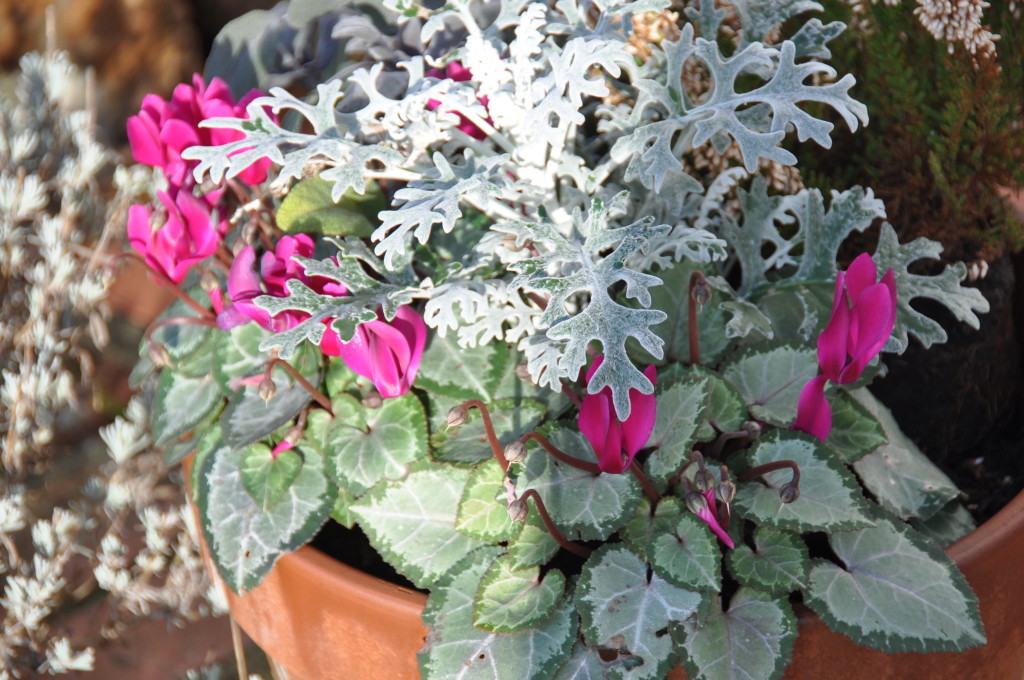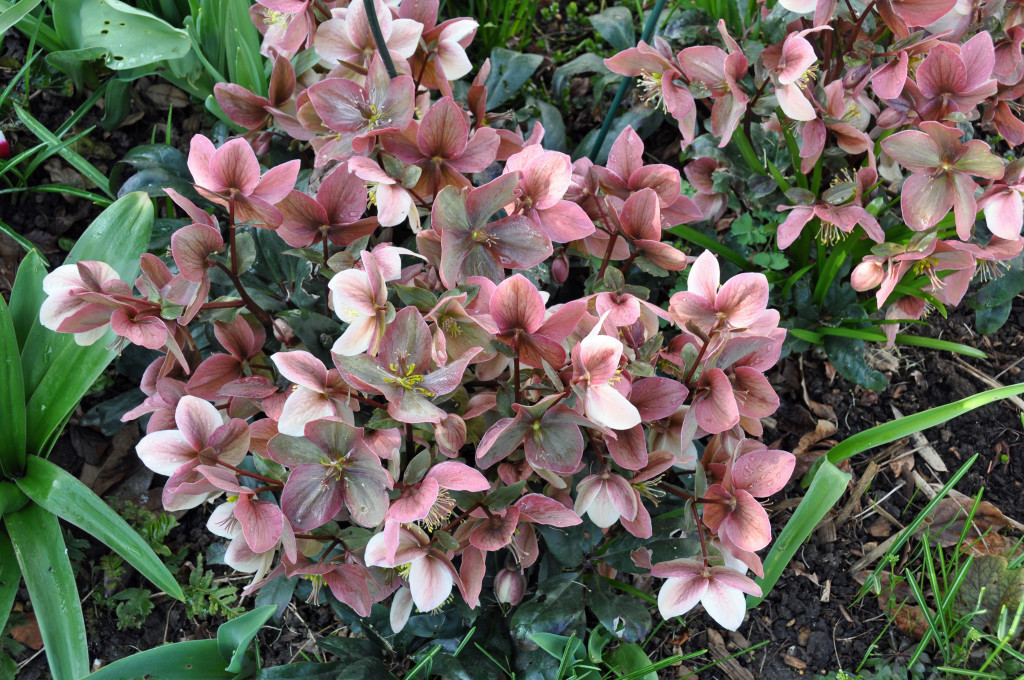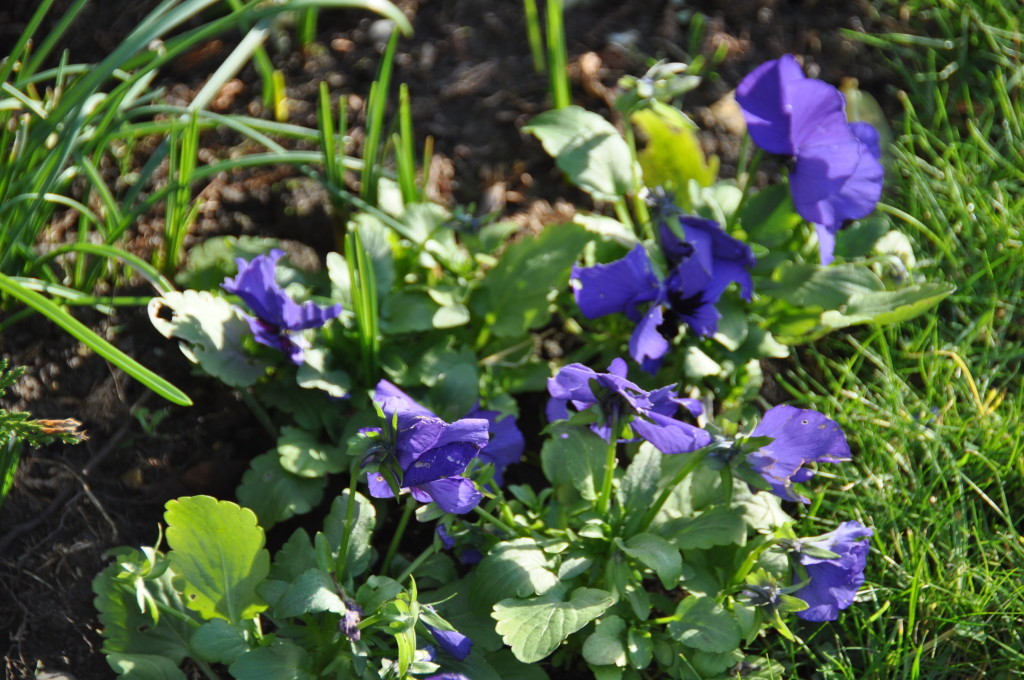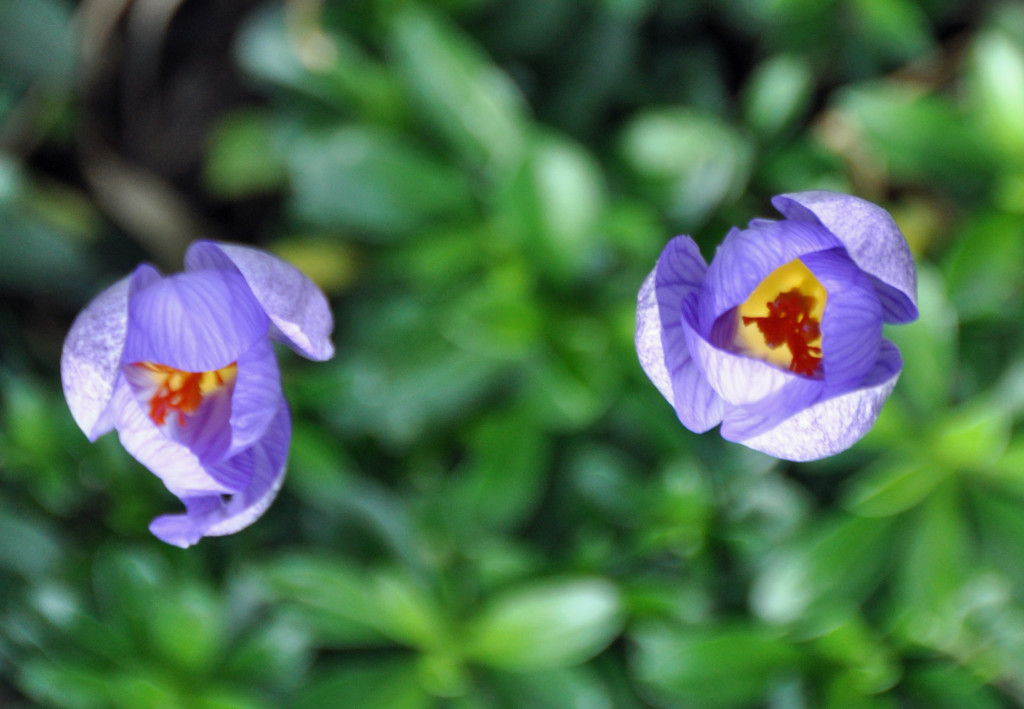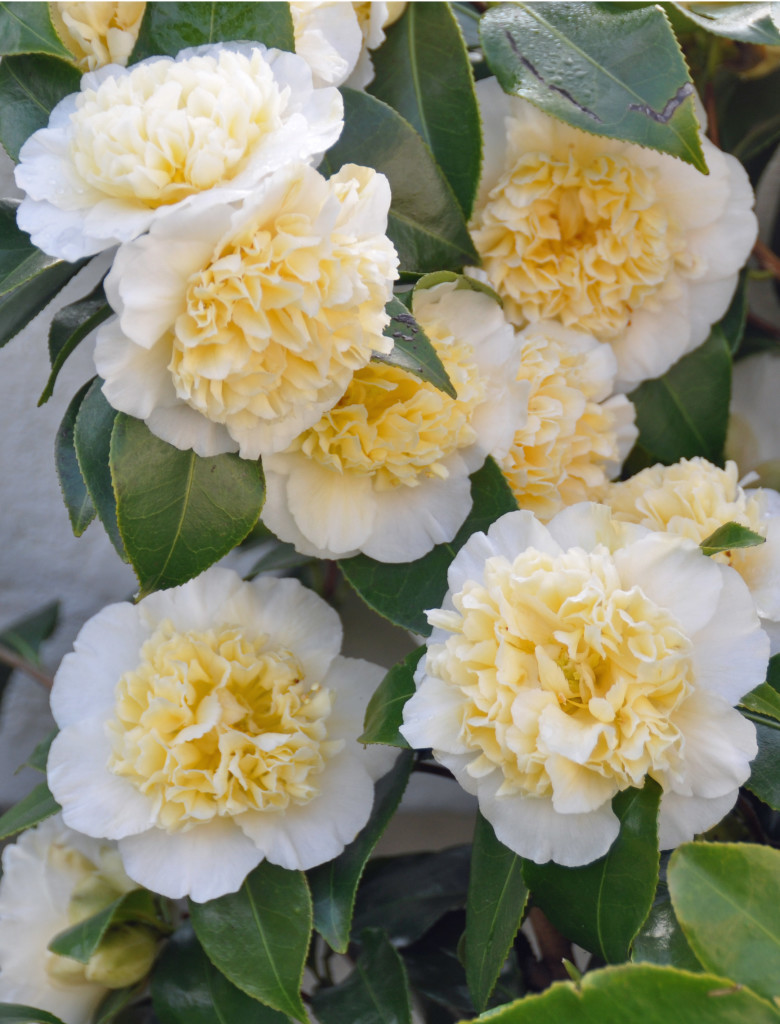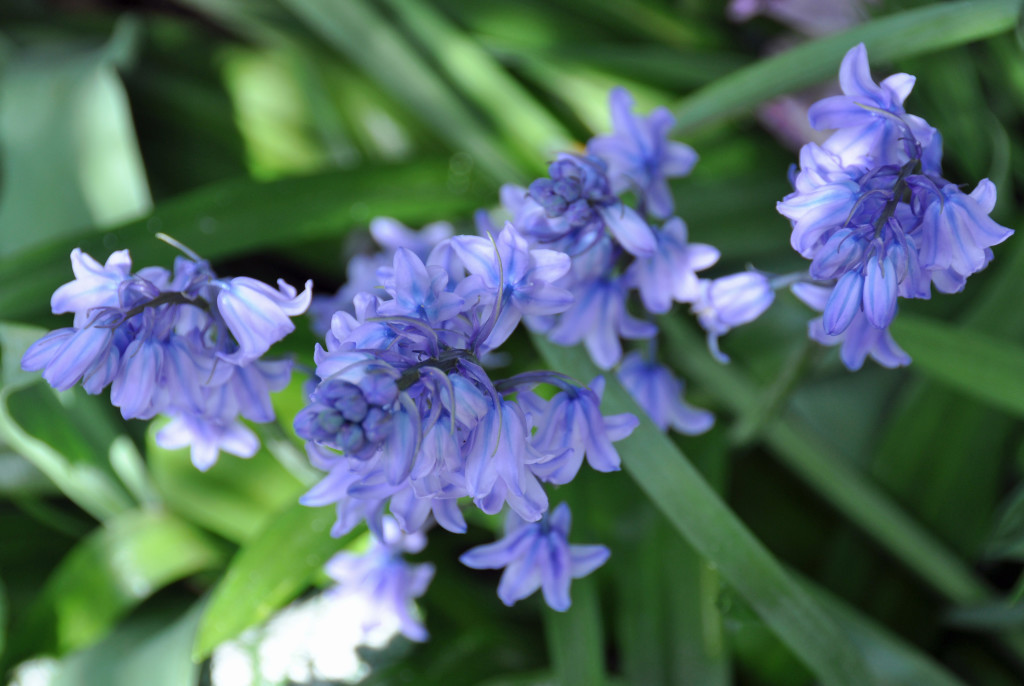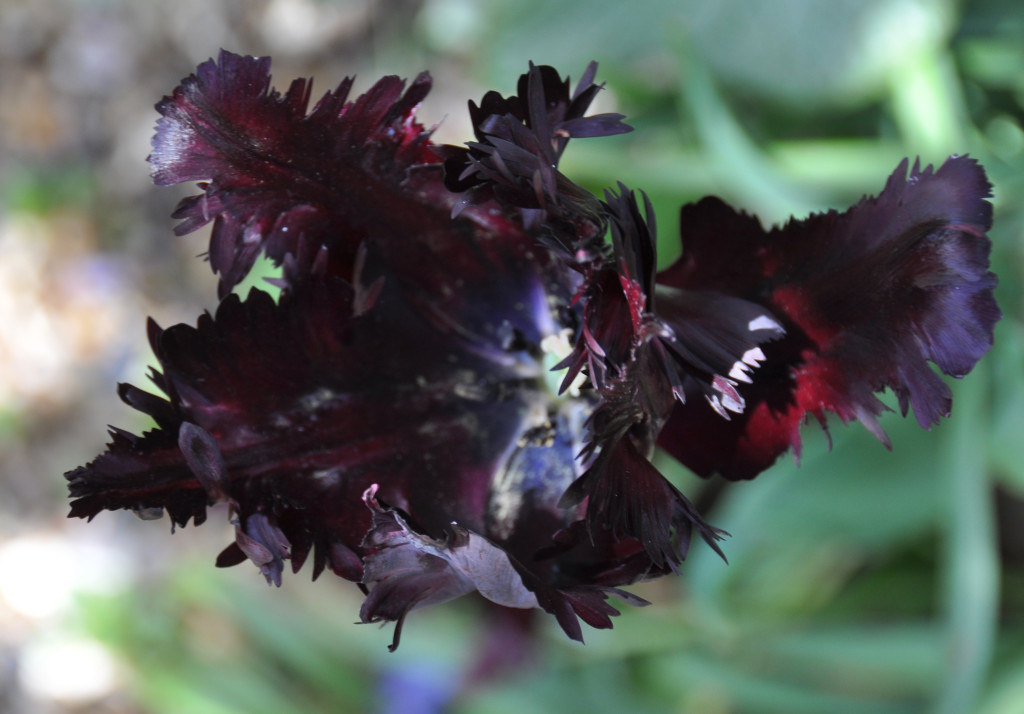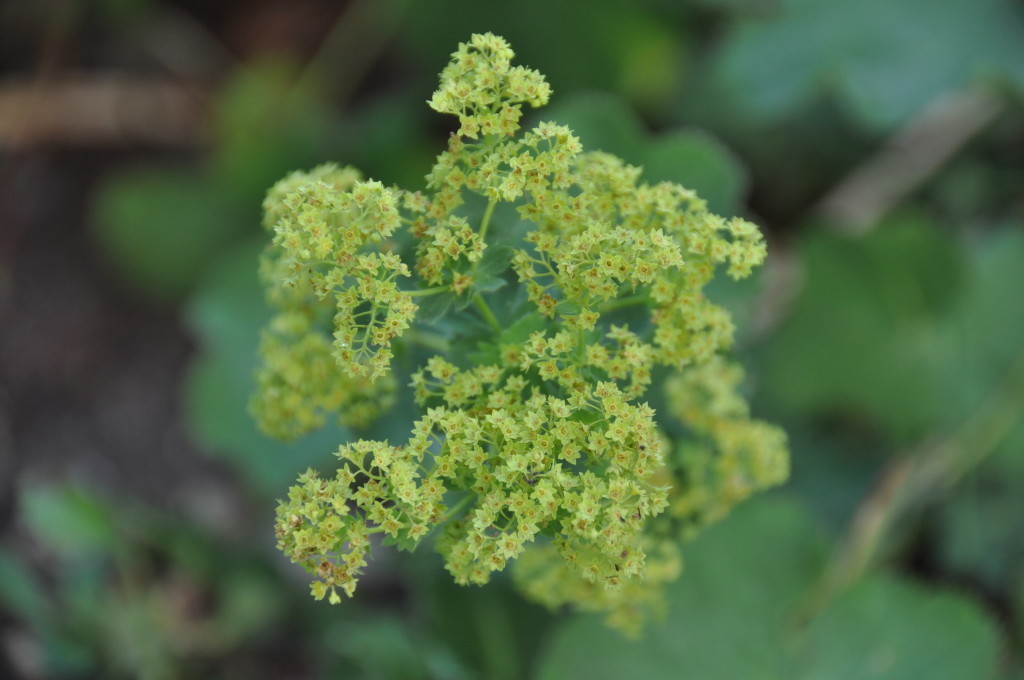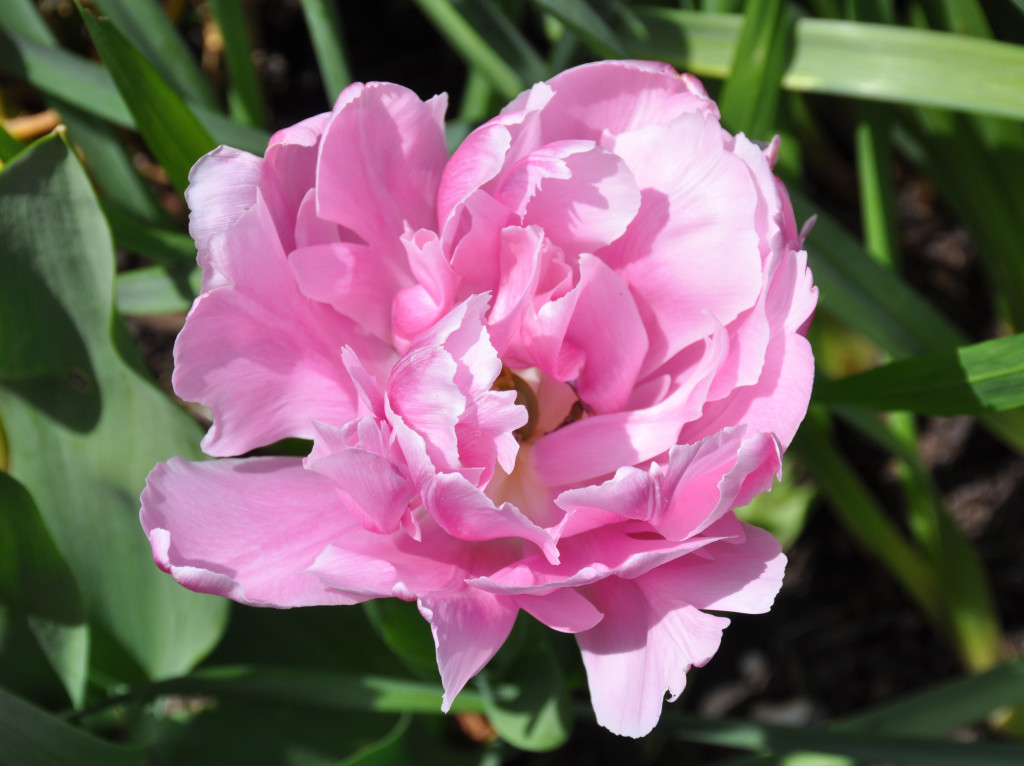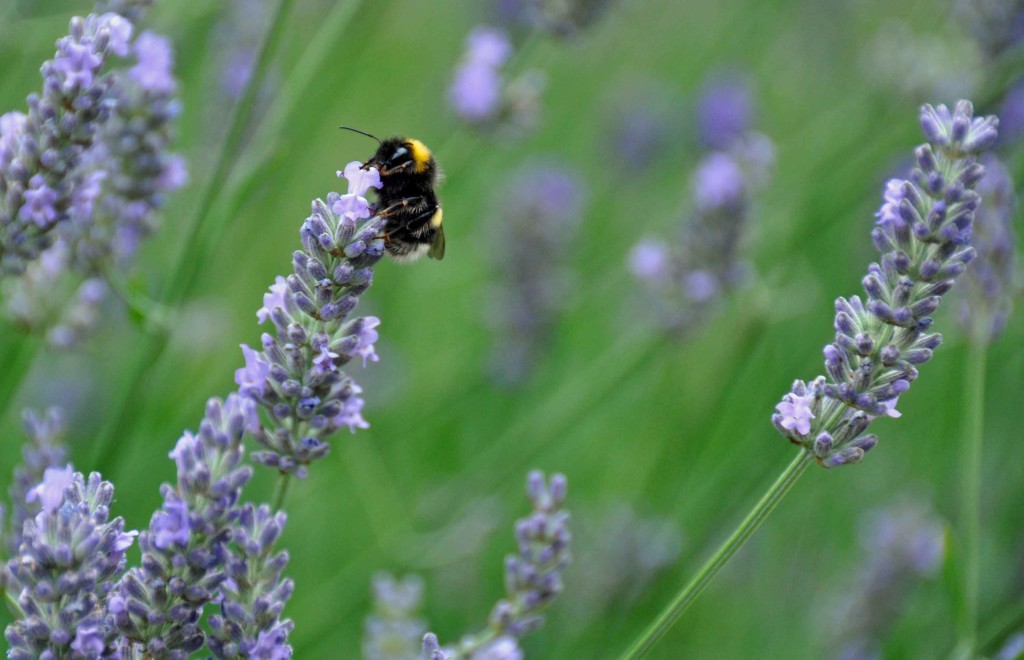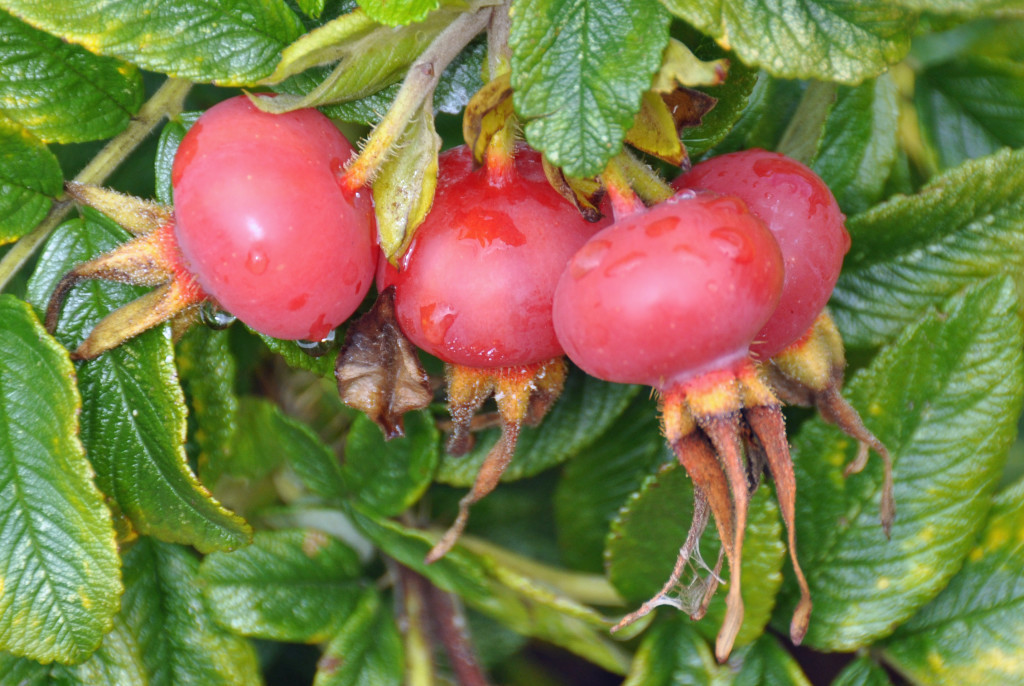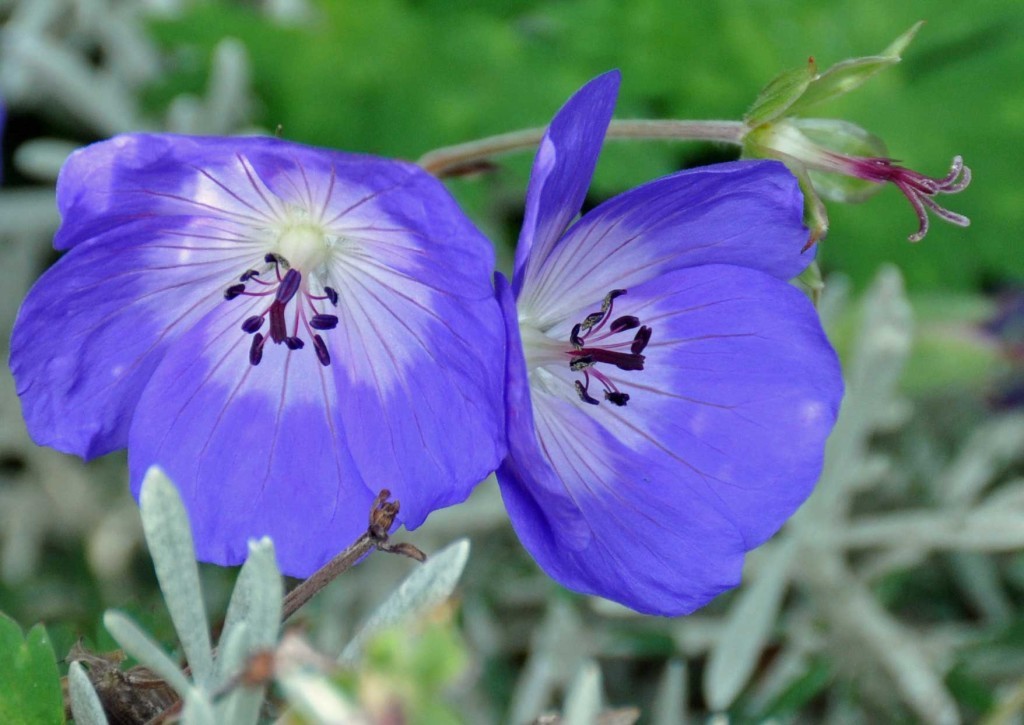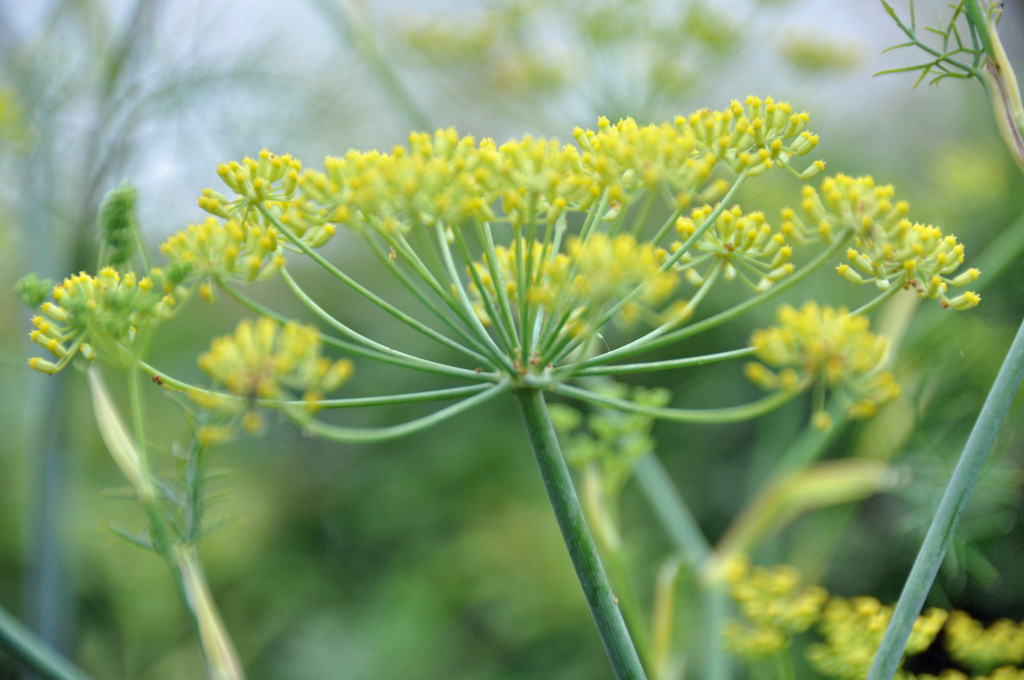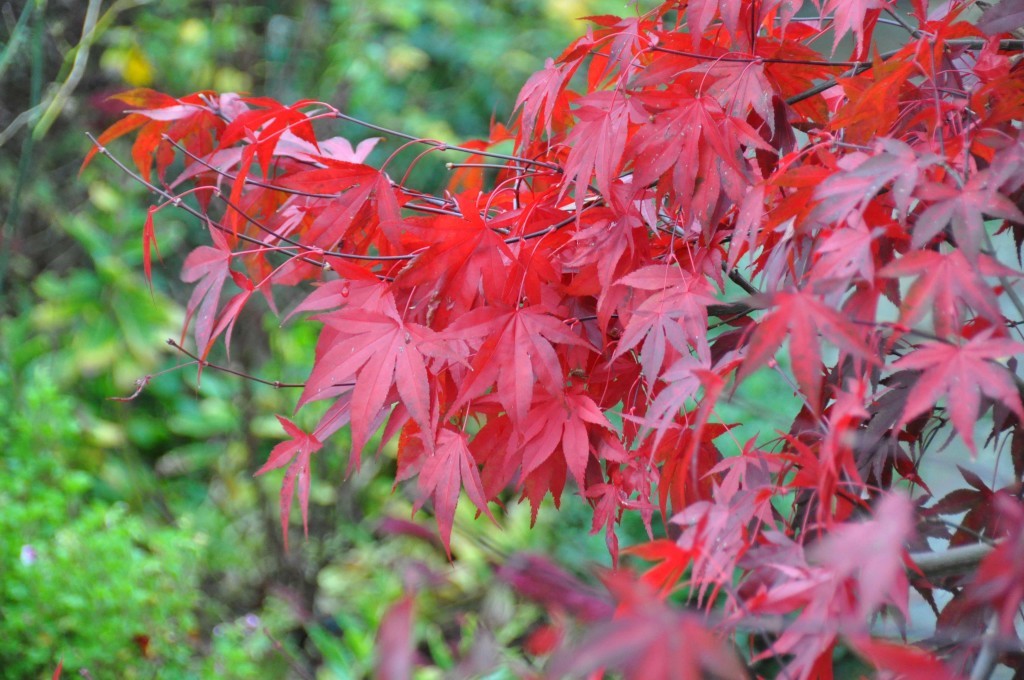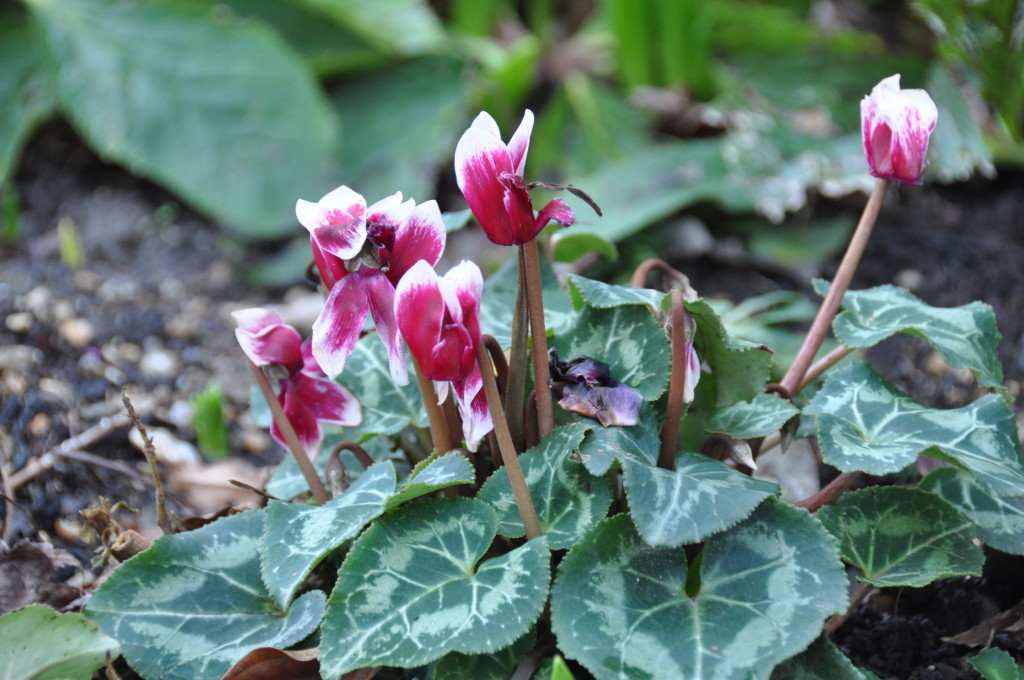January
I’ve decided to keep a record of the garden this year, to keep track of what’s worked, what’s failed abysmally etc. Given that I’m a rubbish gardener we’ll have to see how it goes.
The first month of the year is all about bedding…
Cyclamen are doing their thing in pots and in the borders, whilst hellebores are just about opening up.
February
The early bulbs have arrived in time to cheer me up and on the occasional sunny day, the Winter violas pop up and introduce a splash of colour.
March 2015
The March garden is all about the daffodils, large and small. There is something so happy about a drift of nodding yellow heads bobbing about when everything else is grey and dull.
My neighbour loves them but only in my garden. She has none. They’re just too untidy once the flowers go over and her garden is incredibly neat, unlike mine. her best bet would be the very dainty minature narcissus that have a lot more flower than stem and seem to go over more gracefully.
Rather strangely her flower beds wander all over in gentle swirls whereas mine are all straight edges and corners. Probably as a result, I’m happy to let my plants drift whereas everything next door is kept very firmly clipped in place.
And my partner probably would prefer a bit more order. Maybe once he’s retired we shall buy a lawnmower and he can cut away to his hearts content.
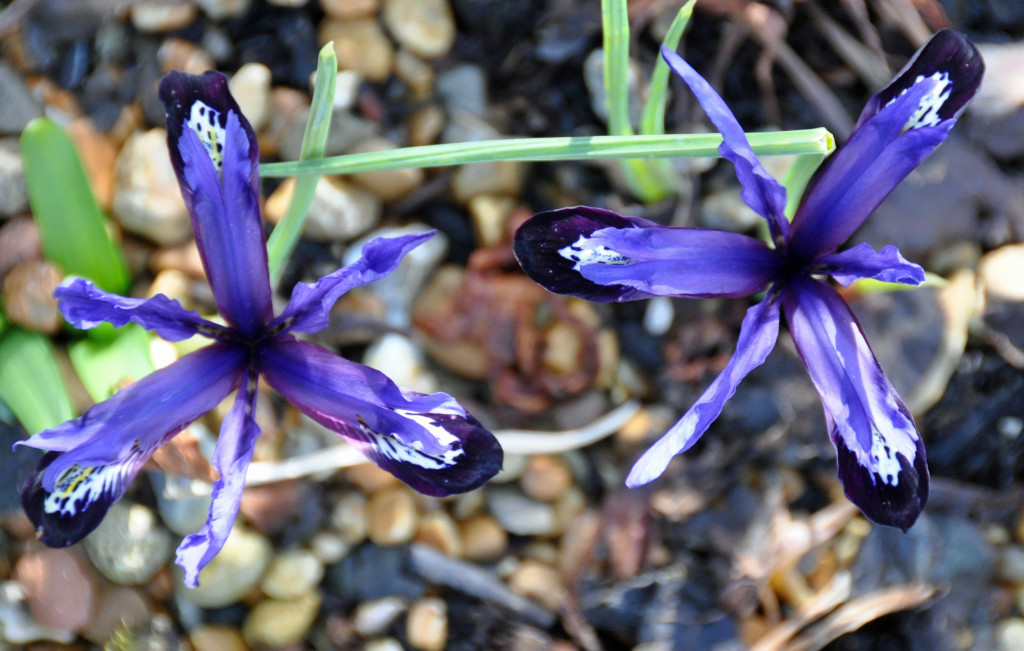 The hellebores have come into their own and are now positively lush. My friends seem to have had no joy with them this year which is a bit strange – mine are lovely. They are supposed to like a bit of damp, and my garden is dry as a bone so I’m always surprised by them. They’ve done well even in the shady section at the back.
The hellebores have come into their own and are now positively lush. My friends seem to have had no joy with them this year which is a bit strange – mine are lovely. They are supposed to like a bit of damp, and my garden is dry as a bone so I’m always surprised by them. They’ve done well even in the shady section at the back.
The euphorbia is just coming into flower and though green is never the most exciting shade in the garden, it is a plant that manages to grow right under the yew so earns it’s keep. The main problem I can see with it, is keeping it stuck in that place and not allowing it to wander too far. A little bit of lime green is good, especially in a difficult spot, but I need to keep diggin up the runners to let the very few flowering plants that survive up there to continue.
The camellia is now in full flight despite being in the worst possible spot for the plant. The worst spot also happens to be the one place I get a good view from the kitchen so it’s lucky it’s decided to get on with life – sometimes the rulebooks just don’t seem to apply.
I have primroses and primulas making the most of a milder Winter and the viola bedding is still going strong.
My friend’s bergenia seems to have popped up for Spring and an alpine aster seems to have flowered continually from October last year – very good value.
The new evergreen sedum seems content in the box planting but the thyme is miserable and will have to be replaced. Maybe I shall have to look at more asters.
April
As the magnolias go over and the camellias fade and die, new plants arrive to cheer us up in the garden including all of the bulbs dug in just before Christmas. We now have a frittelaria border which will probably have some muscari consisitently underplanted for next year.
But everything is slightly earlier than usual. From Easter, London has been having the most lovely weather. It isn’t that unusual to have sunshine in the UK in Spring but we’ve had near Summer temperatures as well and all while the gardens are still green and fresh.
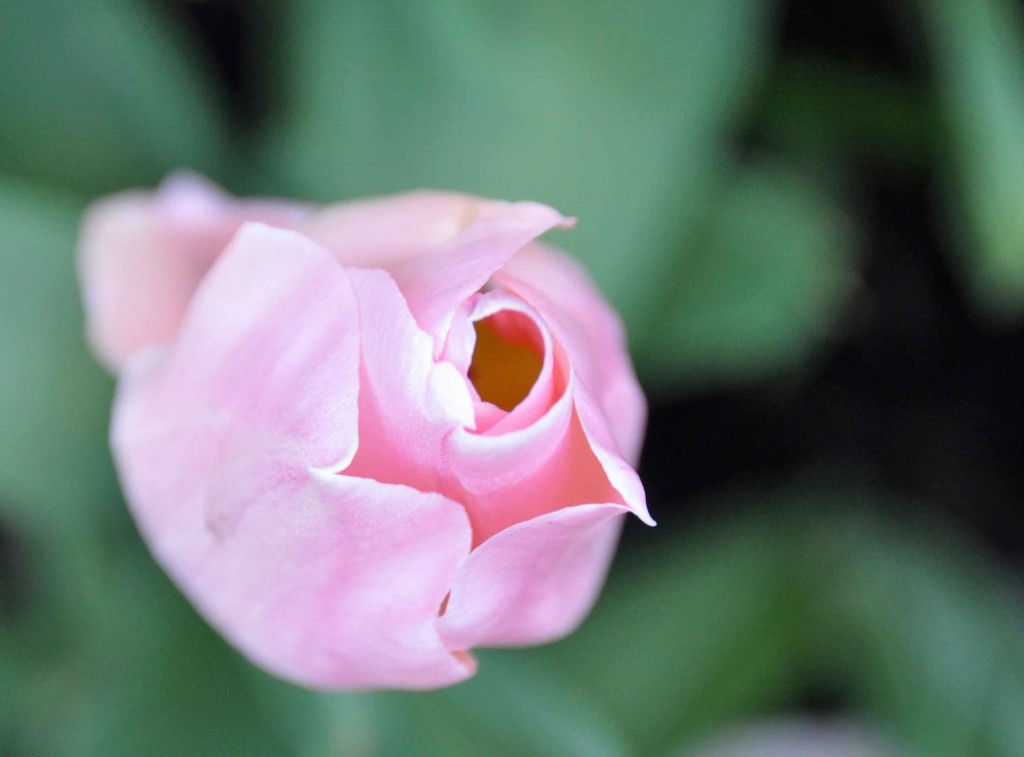 Mostly this month’s garden is a picture of tulips, planted late last year and then even later still, unable to resist the bargains.I ended up with too many for the borders so planted up a couple of troughs. They look surprisingly different, morning and afternoon as the sun hits them and they open up.
Mostly this month’s garden is a picture of tulips, planted late last year and then even later still, unable to resist the bargains.I ended up with too many for the borders so planted up a couple of troughs. They look surprisingly different, morning and afternoon as the sun hits them and they open up.
Rather suprisingly some of last year’s tulips reappeared and toned quite well with the purples and soft peach/pinks put in for this year. Some naturalised tulips have popped through and are such a delicate delight.
But the alpines have also never looked prettier.
In the shade garden the “weeds” are doing well as the hellebores start to fade. I can cope with the comfrey and the forget-me-nots but the other blue thugs are going to have to go.
The epimedium continues with beautiful small yellow flowers but really we’re waiting for the ferns to grow and their greens to show through.
And above all the shady plants, and as a backdrop to the rest of the garden, the pear tree blossom has suddenly appeared.
The trees were planted as part of the plans when the houses were built, alternate pear and apple trees in alternate gardens. It means that we will have a cascade of flowers April-May as each comes into flower.
All in all, the garden is looking lovely and a joy to sit and relax withthe kids and cats.
May
Every month in the garden has it’s own sense of excitement. As the pear tree blossom passes away, the red leaves of the maple suddenly arrive and remind me it’s not all about the flowers.
Then suddenly the wisteria which has been promising much for weeks, suddenly takes over and it isn’t possible to walk in the garden without being wrapped up in the scent. It dominates the garden.
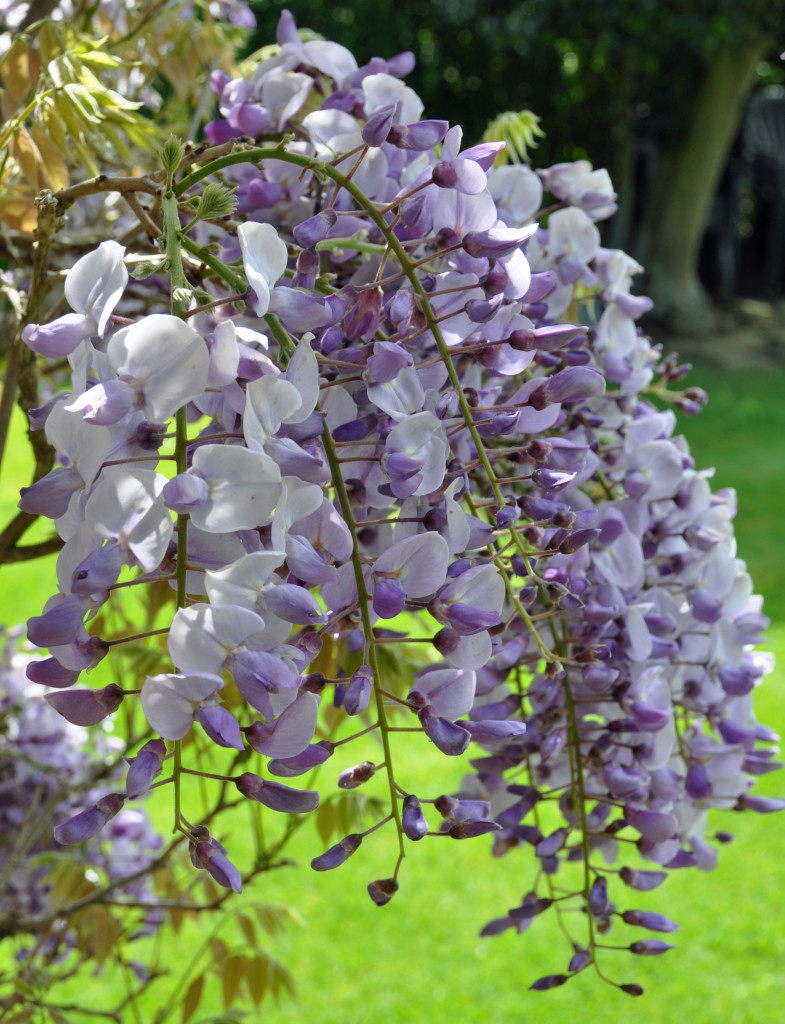 Even the hawthorn hedge suddenly bursts into flowers.
Even the hawthorn hedge suddenly bursts into flowers.
Joined by the early clematis, sprawling over the rose and into the greenery. There is something rather magical about watching the slow unfurl of the ferns around and about the garden, as they slowly but surely come back to life.
But down on the ground, the ovewhelming thug of the month has to be bluebells, not the delicate natives but the Spanish imports. If they weren’t so beautiful they’d have been ripped up years ago when we first moved into the house, but they are lovely. Even knowing that they are home to a slug army poised to decimate all other plants, I can’t quite bring myself to be rid of them.
And in the borders the annual wallflowers are showing how much a bargain they were at £1:50 per clump. Two clumps have filled the back border for months.
And the late tulips are still going strong as their early relatives fade and fall.
Just as the maroon of the wallflowers has helped merge the yellows from the fading daffodils into the tulips, the pink and dark purple mix of tulips has really worked well blending into the purple blues of wisteria and bluebells. Helped by the fizzy blue of the forget-me-nots throughout the garden, shade and sun.
This is a dry garden, dry bright sunny gravel beds and troughs, sunny borders with free draining and quite poor soil compared with dry shade where all of the water is sucked up by the surrounding trees and hedges.
In the gravel, alpines come into their own and this month we’ve added an extra set of beds to almost completely cover the whole flat roof. The neighbours have hinted they’d like something similar, but ofcourse it’s not cheap to plant up, not if you want a quick result. At least I have a clear reminder of what we’re working away from – dry moss and disappointment.
Along the edges I’m trying out perenials like erigeron, old daisy toughies that have a long flowering season and are reputed to be impossible to kill. I’ve added some more rhodanthemum and satureja which have done well up there so far but it’s the more delicate looking flowers that are currently catching the eye.
The old blue phlox planted into the gravel from an old pot where it was doing badly, seems suddenly to have come into it’s own.
And surprisingly the rheum pulchellum planted as part of the original plan but not seen for a year or two has reappeared, dancing above the other alpines. There should be a slew of alliums about to pop up all over the garden, but so far the only ones coming into flower are some huge ones down by the house that I forgotton I’d planted – wish I were more organised.
But the old alpines continue to shine – saxifraga and arabis are always reliable.
And the bedding plants for sun and shade, baskets and borders though bought much too early, are now finally in place, still with lots of growing to do. We’ve had some rain, now we need some warmth to push them along.
Back in the shady garden, the woodruff is doing it’s thuggy thing.
The two geraniums are having very different outcomes with one just coming into flower and self-seeding madly around the place whilst the other is already mildewed and fading. It will have to come out. The epimedium sulphureum still seems confident but the brunnera is fading fast.
Above all else in the garden, I am struggling to love the weeds, the thugs that can survive in the dry shade like woodruff and tellima grandiflora. I can’t quite cope with blue bugold and am busy ripping it up. I’ll probably overplant it with blue forget-me-nots, also thuggy weeds but with rather more flower to justify their existence.
The yellow corydalis, pseudofumaria lutea, has planted itself along with the yellow poppies (meconopsis cambrica) and some pink campion (silene dioca). Weirdly, the latter has appeared as a plant for sale in the local garden centres. I might be glad to see it in my dry shade, but it’s not one that I’d pay for – too easily come by from the side of the road or allotment. I rip it out of my sunny borders on a regular basis – why buy a weed?
And down by the house, under the maple tree I am still entirely undecided as to whether I like Soloman’s Seal or not.
If I can keep the sawfly away from it, it will stay a tall structural plant, taking over from the helleborus but with the best will in the world it’s not terribly exciting.
On the other hand, it fills a spot that nothing else is terribly interested in and having planted itself there it seems a little harsh to pull it all out.
June 2015
When my row of houses was built, just over a hundred years ago, they planted up a hedge of dog roses along the front for all of the houses. And whilst most of the full hedges have long gone, there are many stragglers with the odd one or two left in a border.
Some were a glorious deep pink, mine were white and every morning in June when the sun shines and we walk down the path, we find bees dancing in the flowers, buzzing contently collecting the pollen. It is a surprisingly pleasing sight and sound.
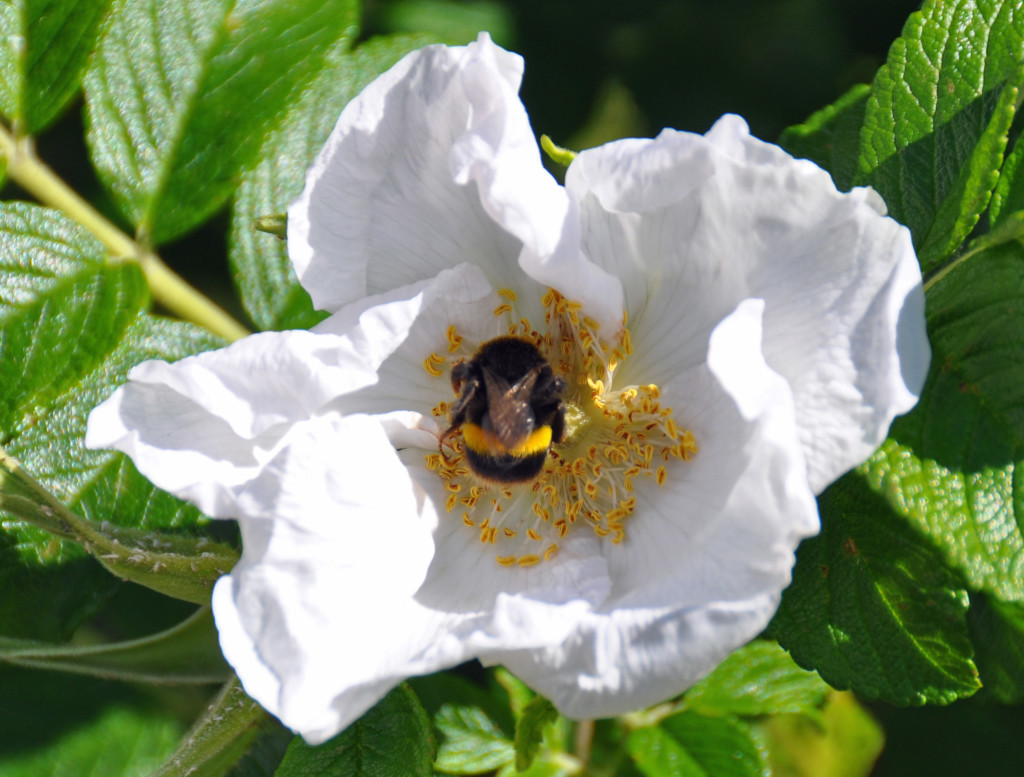 Rather sadly June in my garden seems to be about plans gone awry. I’ve always been pretty rubbish at putting together hanging baskets for Summer and bedding generally and yet again the baskets are a disaster. The geraniums in troughs are ok but the petunias in the back are weedy and useless. Yes, I know that I need to water them.
Rather sadly June in my garden seems to be about plans gone awry. I’ve always been pretty rubbish at putting together hanging baskets for Summer and bedding generally and yet again the baskets are a disaster. The geraniums in troughs are ok but the petunias in the back are weedy and useless. Yes, I know that I need to water them.
The magnolia has now grown leaves and is casting shade over the dry and dismal bed underneath. I’ve lost patience with it and spread some newspaper over the worst of the weeds (which never produce lush growth nevermind any flowers so are worthless) and layered over some gravel. There are a couple of brave ferns, some thuggy violets and some brunnera so there’s some hope left for the space.
Ferns don’t really like dry. There are some that can tolerate it but in reality they could all do with a good water. June is supposed to be the driest month on London so maybe I need to step up my once every other week drenching at least until they’re “established” whatever that might mean.
Most of the Dryopteris Cristata ferns have now been lifted out of the ground in the shady plot, potted and stuck back into the ground .I’m hoping that the pot around their roots will help retain some of the water from the greedy yew and holly hedges. It’s worked for most of them but the pot under the hooly hedge right at the back has yet to throw out new growth and I’ve started to panic. I’ve added some more compost and doused it with water. Now I just need to wait and water.My neighbour’s garden is at it’s best right now – mine is not. A couple of days ago, there was a sad lack of showstoppers but suddenly the roses have flowered and things are looking up. Two pink David Austin roses have suddenly bloomed and look amazing. The yellow rose has also started and the evening scent is wonderful. Now all I have to remember to deadhead them to keep it going.
And running underneath the roses are a couple of rock roses and some cat mint.
And ofcourse we have the unexpected arrivals, wild and those blown in from a nighbour’s garden.
Underneath the holly tree is a barren wasteland, long since dry paved with york stone. A couple of houseleeks, probably dropped from plants on their way up to the garage roof garden, have wedged themselves into the cracks and seem haapy enough. I’ve decided to wedge some more in along with them and see what happens.
But the dominant plant at the moment is clearly the hardy geraniums, in sun or shade.
There are also any number of alliums popping up, both in the gravel beds and the new fritellaria bed.
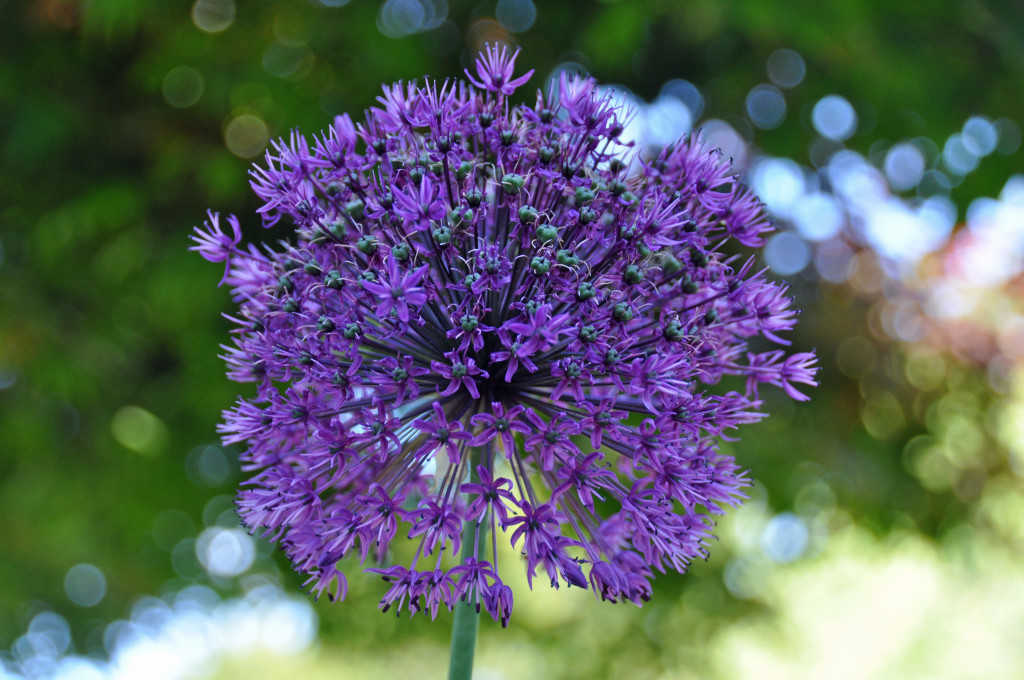 The latter is less than succesful – just too messy. What on earth can be put there for next year to provide a bit more structure with the alpine thrift? Do I really want to keep it all low-lying alpines?
The latter is less than succesful – just too messy. What on earth can be put there for next year to provide a bit more structure with the alpine thrift? Do I really want to keep it all low-lying alpines?
The prettiest (and busiest) part of the garden is the gravel bed on top of the garage, which now has a number of grasses added after some neighbour’s charity plant sales. To make room for the houseleeks under the holly tree, I’ve rescued a very unhappy artemsia alpine to provide a silver foil for the new black grass.
On top of the roof, even the plants that have gone over look lovely.
But down in the main garden, some of the new plants have managed to thrive including the annual sweet peas climbing up my very elderly climbing rose, distracting from the bare stem and thorns.
And everywhere you look there are daisies popping up, specifically Mexican Fleabane which is such a useful as well as pretty thug.
Back in the shady plot, the white geraniums have been and gone and we’re reduced to aquilegias, a month late compared to their cousins in the main garden. Needless to say the weeds live on. At least the campion is pretty.
And in amongst the greenery, the reedy shades of heucharas really stand out and cheer me up.
And although it’s common as can be, there is something very cheerful about the fizzy alchemilla flowers popping over their leaves.
July
By July, many of the garden successes and failures have become clear. Some things are just a matter of taste or lack thereof and some less so. I have a sad liking for vulgar flowers – elegant green and white makes me feel a bit flat.
This is a bit tricky because the backbone of much of my garden is made up of ferns, some large and some small but mostly found in pots. In the shady part of my garden, many of those pots are buried into the ground and are a simple attempt to keep the water with the plant rather than being sucked up by the surrounding trees and hedges.
But the shady garden remains dull. It is considerably better than the bare ground originally planted after the trees were cut back, but it still spends much of the year looking tired.
There are some plants that seem to get by though even the alchemilla mollis isn’t exactly rampant.
Mainly the successes are ground cover plants like ajuga. The purple heucharas have also been useful to leaven all of that so-called restful green
And despite my best efforts the bugold continues to pop up in odd corners.
As does the iris foetidissima with it’s dull flowers preparing the way for bright orange seed pods later in the year. I should probably concede defeat to both, and concentrate on moving the new seedlings into gaps.
In fact it is the bedding that has been the real success in the shady garden this year.
Maybe all I need to do is set aside some more pots for white or golden begonias which really do seem to pop out of the gloom. All-white displays would probably have a degree more impact and elegance but I’m not sure I could bear the lack of excitement.
Outside of the shade, the gravel garden and box are definitely the prettiest parts of the garden.With their border troughs now filled with verbena and erigeron. There is something very cheerful about daisies in the garden, spilling over and out of their place.
And the bedding lobelia that I had leftover so planted into the gravel, have turned out to be beautiful if slightly an odd mix.
The sedum originally found in dribs and drabs on the unplanted garage roof, is thriving and flowers a vibrant yellow. It’s shop bought equivalent will arrive a month or so later and not be quite as astonishing.But the osteospermum and dianthus will need deadheading if I’m to keep them going so strongly.
Maybe I’ve subconciously already begun the move to white with the new thrift plants and creeping thyme doing well in the gravel box next to the lavender hedge.
Plants bought this year seem to be filling out their spots nicely, including the pentemons and the new salvia.
And I’ve even managed to recover some geraniums from last year.
Needless to say, my baskets are an unwieldy disaster. Why on earth did I ever plant lobelias – you just can’t see them from the house at all. Next year I’m going to stick with surfina petunias.
But the perenials that have come back from last year have yet to prove themselves out. The achillea seems a bit lost behind the lavender – maybe it would prefer the gravel.
But I love the sweet peas which I have cut and cut for my breakfast room and still haven’t exhausted. The day lilies are just appearing now.
And the sunny thugs never disappoint.
July – Projects
The good thing about gardening, even with a small suburb garden like mine, is the endless number of projects. A garden is never complete.
And the garden is looking remarkably dry and dusty so there’s plenty to work on. A lot of the plants are at that “going-over” stage though the geraniums are still shining brightly.
And there are some new arrivals in the form of bright pink lilies, feathery fennel and indestructible crocosimia.
My shade garden is especially dry as a bone. I’ve had some success with potting up ferns, some of which are sunk into the ground just to keep the water that does fall around the fern itself rather than being immediately sucked up by the many tree roots. White potted begonias seem quite happy growing in the dark and are helping to make it look more like a garden than a wasteland.
But the holly hedge at the back refuses to thicken up, staying thin and threadbare so I’m looking for a distraction. If possibly I’d just plant something flashy infront of it with a bit of height but the ground is rock hard and desert dry. There were a couple of compost bins there (on the basis that if not beautiful it could at least be useful) so I decided to plant them up and see if that might do the job.
Since they arrived stained a shocking orange, it seemed best to tone them down a bit with a green stain first of all.
And since they’re open wooden slats, I decided to line them with root suppressing fabric, both on the sides and the floor partly to keep the compost in the box and partly to keep the roots of the holly away from competing with my new plants.
Then I just had to choose some plants with a chance of survival, assuming a less than perfect watering regime from me.
Fatsias (castor oil plants) are said to be indestructible. They are evergreen shrubs with stout, sparsely branched stems bearing large, leathery, palmately lobed leaves and small white flowers in terminal compound umbels, followed by small black fruits. They are medium sized, growing upto four metres after 10-20 years.
So I went on-line and found two fatsia japonica “variegata” which are supposed to be fractionally less hardy in the UK, hopefully fine in a warm London environment and will try to remember to keep them watered up.
They are ofcourse tiny relative to the planter but hopefully will grow into it. To soften the planter, I’ve thrown in some ferns on the sides of the boxes and some black grasses on the top. Let’s see if it works.
In the meantime there’s lots of enjoyment to be had from sitting in the sun listening to the buzz of bees on the lavender (and alliums).
PS. The problem fritelaria bed has been stripped of it’s annuals and planted up with geraniums (Johnsons Blue) and alchemilla mollis. It looks very drab right now but I have hopes for next year. There are some allium aflatuensea on order so I could throw those into the mix for a bit of fun, or maybe some allium sphaerocephalon which are currently bobbing their way through the lavender and the gravel bed.
August
August was all about the bees.
Though never enough to stop the cats from trying to hunt them down or worse still the butterflies. Eventually the stings seem to have made them think twice plus and increased supply of rodents and even a frog.
The more you looked at the lavender hedge, the more bees appeared just going about their business. Sitting on the bench effectively surrounded by lavender and the noise of the accompanying bees was a strange mix of pleasure and terror.
With the last of the dog roses disappearing, the hips appeared juicy and red.
Together with the pyracantha it shows the benefits to be found outside of flowers.
So in August we saw the last of the lilies, both true and hemerocallis in one final blaze of glory. They never seem to last long but they are so beuatiful they surely deserve their place.
There are still the occasional flush of flowers on the roses and rock roses, all surrounded by the geranium “rozanne” which is new this year and very beautiful.
The perenial wallflowers given by a friend have flowered right the way through from April – a very pretty purple.
But the real shocker in the border is the arrival of redbeckia goldensturm.
In amongst the lavender, the perovskia has finally bloomed and whilst it’s colour is much more intense than the lavender, it remains too whispy to really have serious impact. Maybe it’s just not big enough as “little spires”.
Of much more value in terms of colour was the contrasting orange of the crocosimia which to be honest I’ve spent a couple of years digging up and throwing away. In a dry year they just wilt and look pathetic but partly because of the late August rains, it seems to have really flourished.
Add in the shocking pink of the penstemons bought this year, and the border is a bit of a vulgar shocker. I think I approve.
Though perhaps the strength of the penstemon colour (not that of “Sour Grapes” which bought and planted at the same time has refused to flower) does make the salvia look a bit tame.
After all of the rain, the dry shady garden is looking a little less dusty though mildew has taken the white geraniums that flowered in the Spring and now also the aquilegias.
It’s still a very contemplative place to sit, though the new installation is perhaps a little loud – still not convinced it’s a success.
The glass decorations are easier on the eye.
There are geraniums flowering away still and ofcourse self seeding everywhere. Since they’ll all die away in the next dry patch, I can’t get too excited.
Asters have appeared to break up the shadows.
And there are begonias scattered about in pots to good effect. I’ll do this again next year but can’t decide whether to stick with all-white or maybe a lemony yellow.
Mainly though it’s about foliage, and heucharas and ajuga have added shades of red and bronze to the greens.
And it turns out that fuschias once flowering don’t need much sunlight at all though they only flower well with lots of water.
The new compost beds are surviving but one is deinitely doing better than the other, largely down to cats digging and scratting.
The cat problem is worse on top of thegarage. Cats and a gravel garden do not make a recipe for success, especially for the slower growing plants like the arenaria or those that only appear late in the year such as the sedums.
It’s not clear to me whether all of the sniffing around by cats is in search of poop or the smell of squirrels. Certainly the buggers seem to have located my bulbs and are one of the reason for all of the digging.
The busier beds don’t seem to have a problem. Certainly some need rather more vigorous policing than others with the satureja turning into a real thug and eryngium popping up everywhere.
The verbena bonaiensis (Lollipop) has flowered through the Summer and is still going strong, set into deeper troughs and acting as a border to the gravel. If the alliums don’t work out in the fritelaria bed I might substitute some of these. Pretty long lasting flowers with an airy open habit are good value.
But the houseleeks are a bit of a bombsite. It might make more sense to relocate the lot of them down to the paving cracks with the rest of the artemisia.
The violas bought almost a year ago are still flowering well – an astonishing bargain. As are the begonias and lobelias bought for bedding all of those months ago are still going strong. I’ve added some new “mums” that I was given as a present.
All of the recent rain has really made the colours pop out from the green. It’s also brought out the spiders. Between the bees and the webs, it’s become a bit of an obstacle course.
September
It has rained solid, and whilst some of the plants (and all of the weeds) have benefitted, it has buffeted and bruised all of the plants coming to the end of their season.
My Summer baskets were never that great but after the last downpour they moved from sad to abject. Since the garden centre was having a sale, I decided to put together some Winter baskets with cyclamen, blue grass, ajuga and lamium.
If they last through to Spring, there are some tiny narcissus hidden away to cheer them up.
Since the geraniums were also battered down, I was persuaded by some heathers to take us through to November.
They never last especially well, and there’s no space in the borders so I shall just have to treat them as disposable bedding.
Having said that, some of the bedding bought last year is still going strong, especially the violas in the front.
The primulas are clearly still with us and waiting their turn in the Spring, whilst the cyclamen have started to peep out from their beds.
As well as the rosehips, the hawthorne hedge is now in fruit so we’re seeing a lot of birds suddenly appear. The cats make this a less than safe garden but some are still willing to risk it.
And I would have to say that the best bedding for this year has clearly been the begonias, for both sun and shade. I know some people who turn their noses up at the idea of such dull plants but they are incredibly reliable even with my less than faithful watering habits.
In the main beds, light and dark, the fuschias are looking cheerful for a good soaking.
And best value new plant, the penstemon Friedrich am Denken is still flowering well. This is in sharp contrats to it’s neighbour, the penstemon Sour Grapes bought at the same time and totally flower-less. It has lots of green growth but no buds. Useless.
From last year, the geranium Rozanne has been beautiful and continues to glow even in the rain. The water on the alchemilla turns a drab plant beautiful.
And I can almost persuade myself that the shade garden is looking lush, if not most colourful.
The asters and potted begonias do help lift the green but it still feels a bit miserly.
I’m hopeful that the fatsia will survive the Winter and come into it’s own over the next couple of years. If only it doesn’t lose it’s variagation in the shade.
Most of the ferns have survived, thrived even. I’m considering transplanting some more from his mother’s garden as a remembrance. It struck both of us as somewhat ironic when I transplanted some of her “London’s Pride” to my London garden. The best gardens are full of memories, keepsakes and friendship tokens.
In the sunny border, the gladioli are looking fresh and white – I need to use white more often – whilst the rudbeckia is a jolly yellow.
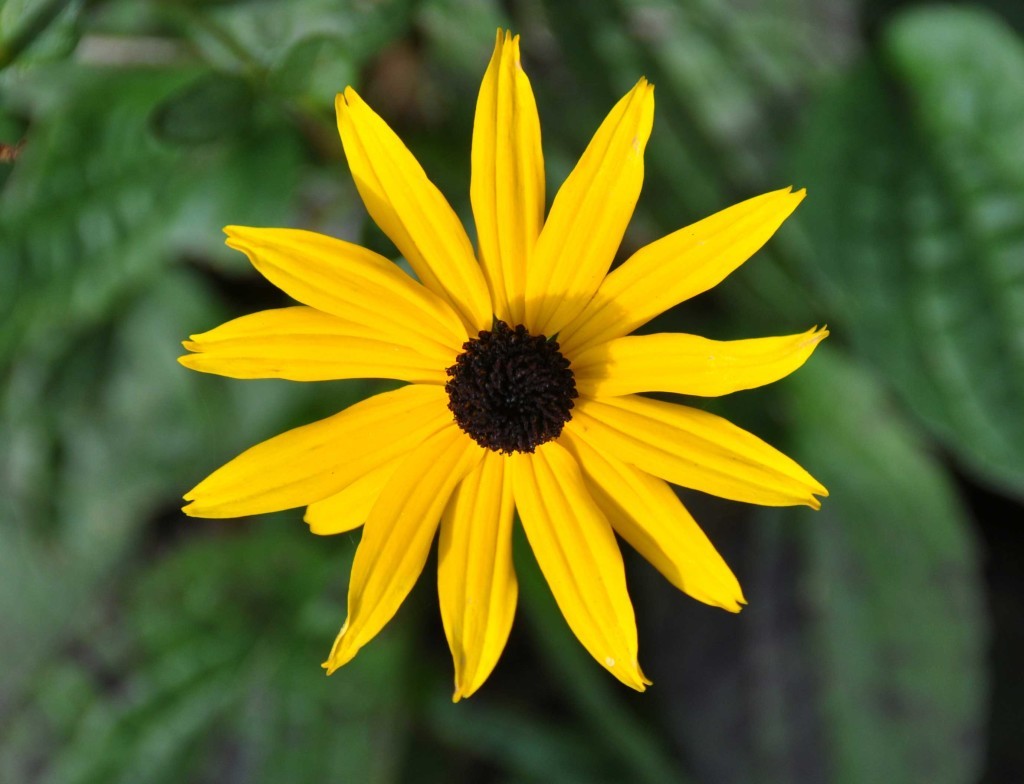 My friends wallflowers have put on a good show all Summer and are still going strong so definitely the best freebie of the year.
My friends wallflowers have put on a good show all Summer and are still going strong so definitely the best freebie of the year.
The perovskia is still going strong whilst the lavender has been cut back. There are now some very disappointed bees trawling up and down.
Up on the gravel roof, the satureja is taking over it’s neighbour’s beds, whilst the verbena shines down into the rest of the garden, spilling over the border.
I’ve decided that the contrast between the black grass and silver artemesia is worth keeping and maybe extending to another bed as the lobelias put in to fill-up new beds dies back..
But mainly in th egravel the job is one of refereeing between the thugs especially satureja and fleabane.
Down in the paving cracks, the houseleeks are glad to be out of the competition.
Though the sedum seems to be holding it’s own. Just. It seems to be more troubled by bulb hunting squirrels and scratting cats than it’s fellow alpines.
October
It’s October and the leaves are well into the changes for Autumn, in fact foliage is pretty much the topic of the month. The trees in the garden seem to lose their leaves to a pre-set order and first come the leaves from the old pear tree.
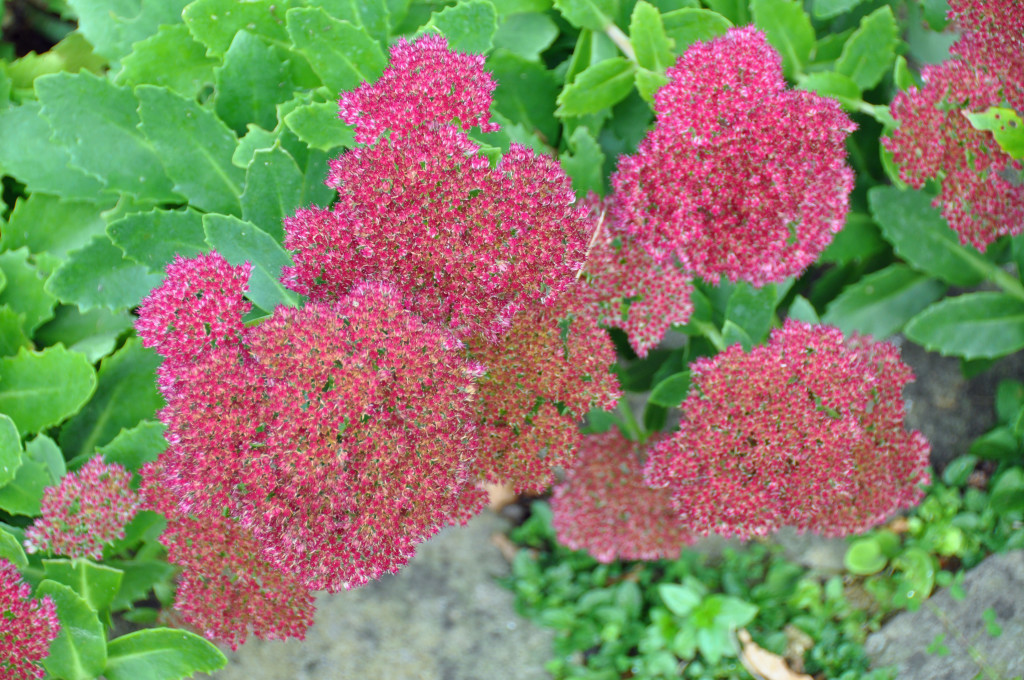 I’m trying to rake up most of the leaves to set aside for leaf mould. rather sadly it takes about two years for the leaves once gathered into bags to rot down and become useful. Unlike normal compost, the rotting down is supposed to be driven by fungal degradation, being a cold rather than hot process. So there isn’t much to do other than gather the leaves up into bags or piles and find a quiet place in the garden to set them aside. In an ideal world I’ll keep the piles just a little bit wet.
I’m trying to rake up most of the leaves to set aside for leaf mould. rather sadly it takes about two years for the leaves once gathered into bags to rot down and become useful. Unlike normal compost, the rotting down is supposed to be driven by fungal degradation, being a cold rather than hot process. So there isn’t much to do other than gather the leaves up into bags or piles and find a quiet place in the garden to set them aside. In an ideal world I’ll keep the piles just a little bit wet.
It’s amazingly good stuff to use to mulch around plants especially in dry areas because it absorbs so much water to slow release once the rains have gone. I’ve set aside one of the composters in the shady garden to hold all of the fallen leaves and we’ll see how it goes.
At this time of year, the shady plot is actually looking about as good as it gets, which is to say almost lush and woodlike. Most of the ferns are at their best from now until Spring in the cooler, wetter months.
The begonias are still flowering their hearts out and the asters are doing their best, but in reality, it’s the play of different foliage colours that make it more interesting.
The heucharas are flowering as well as having beautiful bronzed leaves so they probably earn double points.
And although not very substantial, the texture of the flowers is interesting especially when set against the hard corners of planters etc.
The low level foliage in ajuga is looking quite glossy and the lamium, essentially dumped because I picked up too many last time I visited the garden centre seems to have found it’s place.
I’m almost convinced that next year I’ll go for lemon yellow colours – th eorange is just a little bit more interesting than the white.
Back in the sunshine and the garden is mainly about sedums one way or another whether in the main borders or in the gravel garden.
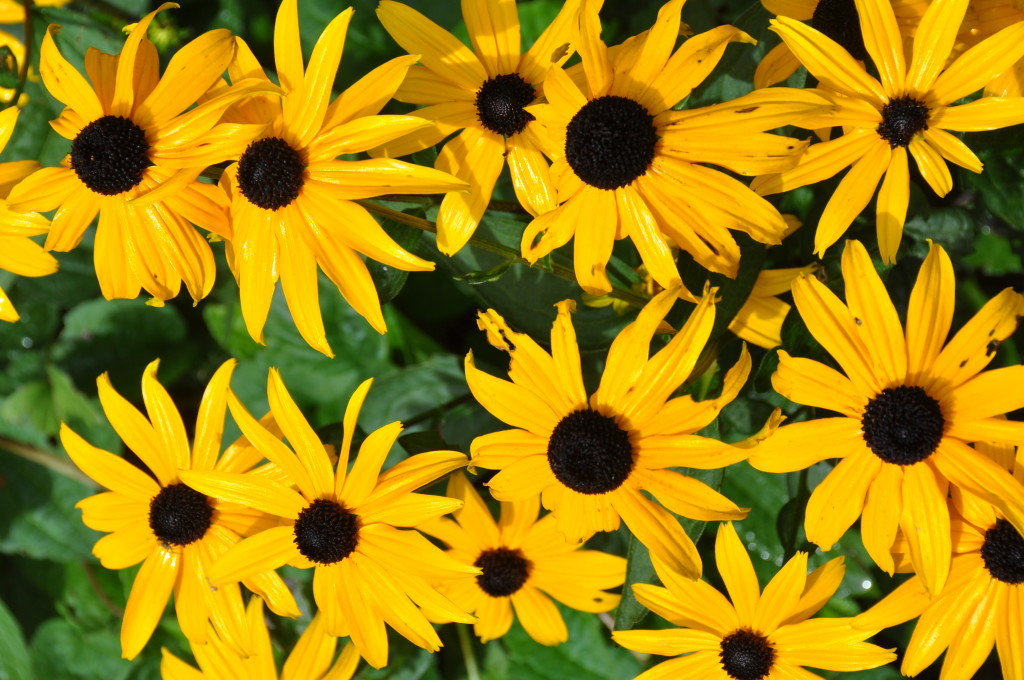 Though even here it’s the contrast in foliage that seems to catch the eye most.
Though even here it’s the contrast in foliage that seems to catch the eye most.
It’s one of those times of year when I end up moving plants around a bit. The iris foetidissima self-seeds all over the shady garden so I end up digging the seedlings up and putting them into a (very) dry patch where they can’t threaten anything else.
I’ve moved some geranium (Johnson’s Blue) from the sunny borders where they were getting lost into the dappled shade at the back. They may not love their new spot but it can’t be worse than the one they were in.
In the meantime the Geranimu Rozanne just keeps on giving with such beatiful clear blue flowers.
I also decided to move the rather delicate achillea from a rather boisterous sunny border to the gravel garden. We’ll have to see next year how it copes with the move.
Ignoring the fact that it might kill my cats, I’ve decided to plant some foxtail lilies in amongst the lavender.
My neighbour has some, and the cats seem to be totally uninterested. They are the strangest looking things to plant and because of the cats, I’ve perhaps planted them deeper than they’ll like. We’ll have to wait and see what pops up next year.
I’ve also dug out some parts of the lawn nearest the house and underplanted some Spring crocus. In reality, the Spring garden doesn’t get much of a physical appreciation, more a quick look from the window so I might as well stick things where they can be seen. Part of the pull has to be the enjoyment that I’m taking from the current batch of autumn crocus. I’ve stuck some of them into the gravel as well.
The nastutium seeds, like the sweetpeas ahead of them have proved to be a total bargain this year and are just so very cheerful.
Even my baskets are looking decidedly perky. Why can’t I manage Summer baskets that look half-way decent? It seems that my total inability to water really is that fatal.
Even in the sun, the bright silver foliage of silver leaf is hiding the backside of my lavender. It should die off in Winter but three years later and I’m still waiting for the temperatures to drop that low.
And all of the regulars are still flowering strong inclduing my new favourite, the penstemon Friedrich am Denken
Even the bedding, the snapdragons etc are putting on a show and there are still some perfect rudbeckias to be found as most of the flower heads start to look more like brown bumbles.
Up in the gravel, the geranium is having a second flush as the aster suddenly bursts into flower.
Last year’s Winter bedding, the primulas has also come back to shine.
And if the fleabane and verbena are looking just a little tired, the occasional flower from the dianthus and osteospermum still delight.
Just as the crocus pop up all around, the early cyclamen are arriving looking so delicate under the trees.
This has to be my favourite part of the year.
November
Looking out into my November garden I’m struck by how very green it all seems and how well the viburnum in my neighbours’ gardens are looking. It’s a month of two halves, starting out quite bright and colourful with flowers and foliage, ending up quite staid.
It starts out busy, choosing and planting bulbs for Spring and rapidly becomes a race against frost.
There’s a beautiful kaffir lily next door as well, really vibrant pink and no use to me whatsoever. They need damp. Whilst my garden is dry as a bone, the neighbour has the remains of an underground stream running down one side. She can grow everything that I long for, even boggy plants and soggy ferns. So jealous.
Ofcourse she hates the wet.
So with the weather about to change I have headed out to the garden centres at Crews Hill and brought home some Winter bedding to cheer myself up, mainly cyclamens, violas (pansies) and some primulas.
It’s late, but I also planned on digging in my tulips from last year supplemented by some new whites just bought on-line. Last year’s tulip bulbs had not survived well. It seems clear that mice had found them – about half had been nibbled into nothing.
I always leave it too late to have any real choice in the bulbs, since I buy just before planting and for tulips that means November. The later they’re left, the less chance there is of anything going wrong with their growth.
At the start of the month the leaves were turning and the acer in particular was the most beautiful red.
Now mostly all of the leaves have fallen and been collected and binned in the shady garden to make leaf mould (shove it in a dark spot, water occasionally and after a year or two, save yourself a fortune on compost).
Since I’m gradually planting up the compost bins in the back, I won’t even have to move the compost, just plant something pretty on the top and sides. Hopefully.
During Summer, the bird feeders were all hidden away but now I can easily see the tits fighting it out over mealworms and seed. So can the three cats.
I’m conflicted about whether or not it’s best to put out feeders, even high and safely away from the cats. Obviously as the birds feed, they drop seed onto the grass underneath and it’s worrying to think that a bird might be tempted to risk the ground.
On the other hand, both neighbours already have feeders out and operating and I haven’t seen a great influx of bird carcasses.Plus it’s mainly canny old London pigeons that I find cropping the lawn and my cats will never hunt down one of them.
The three cats seem pretty fixated on rodents and I can’t really complain about them following through on their nature, not for mice. We’re averaging one or two a week which will taper off as they get old and lazy (ier?).
It’s been an astonishingly warm November I’m told, but that all changed with temperatures falling steadily from 10C down to around 0C by last weekend. It became a mad race against time and rain to get tulip bulbs planted.
 The first frost put an end to the begonias which were still flowering their heads off in pots dotted around the shade. They have easily been one of the better ideas of 2015. The snapdragons are also having a last fling where as the bedding geraniums are settling down for Winter. If it’s mild, they’ll survive in London and reappear to flower in the Summer.
The first frost put an end to the begonias which were still flowering their heads off in pots dotted around the shade. They have easily been one of the better ideas of 2015. The snapdragons are also having a last fling where as the bedding geraniums are settling down for Winter. If it’s mild, they’ll survive in London and reappear to flower in the Summer.
So will the fuschias in pots at the back but since I am always slow to water and feed, they never really show well. Maybe I should just get rid of them now and buy new. Once they start to put on new growth it seems a bit mean to throw them out and they have given me three or four years of enjoyment. Maybe that’s enough.
The local garden centre had an offer on variegated fatsia, which will be ideal for my shady garden so another couple arrived home with the bedding. They cost half as much and are twice the size of the two ordered on-line earlier in the year – hate that. But ofcourse they spend the first frost wilting and losing their top leaves. Hopefully they’ll recover come Spring.
There is also the promise of flowers to come, with the bulbs putting out their foliage and helleborus starting to flower.
It feels like the garden is waiting for something to happen all expectation and wishful thinking.
January
I’ve decided to keep a record of the garden this year, to keep track of what’s worked, what’s failed abysmally etc. Given that I’m a rubbish gardener we’ll have to see how it goes.
The first month of the year is all about bedding…
Cyclamen are doing their thing in pots and in the borders, whilst hellebores are just about opening up.
February
The early bulbs have arrived in time to cheer me up and on the occasional sunny day, the Winter violas pop up and introduce a splash of colour.
March 2015
The March garden is all about the daffodils, large and small. There is something so happy about a drift of nodding yellow heads bobbing about when everything else is grey and dull.
My neighbour loves them but only in my garden. She has none. They’re just too untidy once the flowers go over and her garden is incredibly neat, unlike mine. her best bet would be the very dainty minature narcissus that have a lot more flower than stem and seem to go over more gracefully.
Rather strangely her flower beds wander all over in gentle swirls whereas mine are all straight edges and corners. Probably as a result, I’m happy to let my plants drift whereas everything next door is kept very firmly clipped in place.
And my partner probably would prefer a bit more order. Maybe once he’s retired we shall buy a lawnmower and he can cut away to his hearts content.
 The hellebores have come into their own and are now positively lush. My friends seem to have had no joy with them this year which is a bit strange – mine are lovely. They are supposed to like a bit of damp, and my garden is dry as a bone so I’m always surprised by them. They’ve done well even in the shady section at the back.
The hellebores have come into their own and are now positively lush. My friends seem to have had no joy with them this year which is a bit strange – mine are lovely. They are supposed to like a bit of damp, and my garden is dry as a bone so I’m always surprised by them. They’ve done well even in the shady section at the back.
The euphorbia is just coming into flower and though green is never the most exciting shade in the garden, it is a plant that manages to grow right under the yew so earns it’s keep. The main problem I can see with it, is keeping it stuck in that place and not allowing it to wander too far. A little bit of lime green is good, especially in a difficult spot, but I need to keep diggin up the runners to let the very few flowering plants that survive up there to continue.
The camellia is now in full flight despite being in the worst possible spot for the plant. The worst spot also happens to be the one place I get a good view from the kitchen so it’s lucky it’s decided to get on with life – sometimes the rulebooks just don’t seem to apply.
I have primroses and primulas making the most of a milder Winter and the viola bedding is still going strong.
My friend’s bergenia seems to have popped up for Spring and an alpine aster seems to have flowered continually from October last year – very good value.
The new evergreen sedum seems content in the box planting but the thyme is miserable and will have to be replaced. Maybe I shall have to look at more asters.
April
As the magnolias go over and the camellias fade and die, new plants arrive to cheer us up in the garden including all of the bulbs dug in just before Christmas. We now have a frittelaria border which will probably have some muscari consisitently underplanted for next year.
But everything is slightly earlier than usual. From Easter, London has been having the most lovely weather. It isn’t that unusual to have sunshine in the UK in Spring but we’ve had near Summer temperatures as well and all while the gardens are still green and fresh.
 Mostly this month’s garden is a picture of tulips, planted late last year and then even later still, unable to resist the bargains.I ended up with too many for the borders so planted up a couple of troughs. They look surprisingly different, morning and afternoon as the sun hits them and they open up.
Mostly this month’s garden is a picture of tulips, planted late last year and then even later still, unable to resist the bargains.I ended up with too many for the borders so planted up a couple of troughs. They look surprisingly different, morning and afternoon as the sun hits them and they open up.
Rather suprisingly some of last year’s tulips reappeared and toned quite well with the purples and soft peach/pinks put in for this year. Some naturalised tulips have popped through and are such a delicate delight.
But the alpines have also never looked prettier.
In the shade garden the “weeds” are doing well as the hellebores start to fade. I can cope with the comfrey and the forget-me-nots but the other blue thugs are going to have to go.
The epimedium continues with beautiful small yellow flowers but really we’re waiting for the ferns to grow and their greens to show through.
And above all the shady plants, and as a backdrop to the rest of the garden, the pear tree blossom has suddenly appeared.
The trees were planted as part of the plans when the houses were built, alternate pear and apple trees in alternate gardens. It means that we will have a cascade of flowers April-May as each comes into flower.
All in all, the garden is looking lovely and a joy to sit and relax withthe kids and cats.
May
Every month in the garden has it’s own sense of excitement. As the pear tree blossom passes away, the red leaves of the maple suddenly arrive and remind me it’s not all about the flowers.
Then suddenly the wisteria which has been promising much for weeks, suddenly takes over and it isn’t possible to walk in the garden without being wrapped up in the scent. It dominates the garden.
 Even the hawthorn hedge suddenly bursts into flowers.
Even the hawthorn hedge suddenly bursts into flowers.
Joined by the early clematis, sprawling over the rose and into the greenery. There is something rather magical about watching the slow unfurl of the ferns around and about the garden, as they slowly but surely come back to life.
But down on the ground, the ovewhelming thug of the month has to be bluebells, not the delicate natives but the Spanish imports. If they weren’t so beautiful they’d have been ripped up years ago when we first moved into the house, but they are lovely. Even knowing that they are home to a slug army poised to decimate all other plants, I can’t quite bring myself to be rid of them.
And in the borders the annual wallflowers are showing how much a bargain they were at £1:50 per clump. Two clumps have filled the back border for months.
And the late tulips are still going strong as their early relatives fade and fall.
Just as the maroon of the wallflowers has helped merge the yellows from the fading daffodils into the tulips, the pink and dark purple mix of tulips has really worked well blending into the purple blues of wisteria and bluebells. Helped by the fizzy blue of the forget-me-nots throughout the garden, shade and sun.
This is a dry garden, dry bright sunny gravel beds and troughs, sunny borders with free draining and quite poor soil compared with dry shade where all of the water is sucked up by the surrounding trees and hedges.
In the gravel, alpines come into their own and this month we’ve added an extra set of beds to almost completely cover the whole flat roof. The neighbours have hinted they’d like something similar, but ofcourse it’s not cheap to plant up, not if you want a quick result. At least I have a clear reminder of what we’re working away from – dry moss and disappointment.
Along the edges I’m trying out perenials like erigeron, old daisy toughies that have a long flowering season and are reputed to be impossible to kill. I’ve added some more rhodanthemum and satureja which have done well up there so far but it’s the more delicate looking flowers that are currently catching the eye.
The old blue phlox planted into the gravel from an old pot where it was doing badly, seems suddenly to have come into it’s own.
And surprisingly the rheum pulchellum planted as part of the original plan but not seen for a year or two has reappeared, dancing above the other alpines. There should be a slew of alliums about to pop up all over the garden, but so far the only ones coming into flower are some huge ones down by the house that I forgotton I’d planted – wish I were more organised.
But the old alpines continue to shine – saxifraga and arabis are always reliable.
And the bedding plants for sun and shade, baskets and borders though bought much too early, are now finally in place, still with lots of growing to do. We’ve had some rain, now we need some warmth to push them along.
Back in the shady garden, the woodruff is doing it’s thuggy thing.
The two geraniums are having very different outcomes with one just coming into flower and self-seeding madly around the place whilst the other is already mildewed and fading. It will have to come out. The epimedium sulphureum still seems confident but the brunnera is fading fast.
Above all else in the garden, I am struggling to love the weeds, the thugs that can survive in the dry shade like woodruff and tellima grandiflora. I can’t quite cope with blue bugold and am busy ripping it up. I’ll probably overplant it with blue forget-me-nots, also thuggy weeds but with rather more flower to justify their existence.
The yellow corydalis, pseudofumaria lutea, has planted itself along with the yellow poppies (meconopsis cambrica) and some pink campion (silene dioca). Weirdly, the latter has appeared as a plant for sale in the local garden centres. I might be glad to see it in my dry shade, but it’s not one that I’d pay for – too easily come by from the side of the road or allotment. I rip it out of my sunny borders on a regular basis – why buy a weed?
And down by the house, under the maple tree I am still entirely undecided as to whether I like Soloman’s Seal or not.
If I can keep the sawfly away from it, it will stay a tall structural plant, taking over from the helleborus but with the best will in the world it’s not terribly exciting.
On the other hand, it fills a spot that nothing else is terribly interested in and having planted itself there it seems a little harsh to pull it all out.
June 2015
When my row of houses was built, just over a hundred years ago, they planted up a hedge of dog roses along the front for all of the houses. And whilst most of the full hedges have long gone, there are many stragglers with the odd one or two left in a border.
Some were a glorious deep pink, mine were white and every morning in June when the sun shines and we walk down the path, we find bees dancing in the flowers, buzzing contently collecting the pollen. It is a surprisingly pleasing sight and sound.
 Rather sadly June in my garden seems to be about plans gone awry. I’ve always been pretty rubbish at putting together hanging baskets for Summer and bedding generally and yet again the baskets are a disaster. The geraniums in troughs are ok but the petunias in the back are weedy and useless. Yes, I know that I need to water them.
Rather sadly June in my garden seems to be about plans gone awry. I’ve always been pretty rubbish at putting together hanging baskets for Summer and bedding generally and yet again the baskets are a disaster. The geraniums in troughs are ok but the petunias in the back are weedy and useless. Yes, I know that I need to water them.
The magnolia has now grown leaves and is casting shade over the dry and dismal bed underneath. I’ve lost patience with it and spread some newspaper over the worst of the weeds (which never produce lush growth nevermind any flowers so are worthless) and layered over some gravel. There are a couple of brave ferns, some thuggy violets and some brunnera so there’s some hope left for the space.
Ferns don’t really like dry. There are some that can tolerate it but in reality they could all do with a good water. June is supposed to be the driest month on London so maybe I need to step up my once every other week drenching at least until they’re “established” whatever that might mean.
Most of the Dryopteris Cristata ferns have now been lifted out of the ground in the shady plot, potted and stuck back into the ground .I’m hoping that the pot around their roots will help retain some of the water from the greedy yew and holly hedges. It’s worked for most of them but the pot under the hooly hedge right at the back has yet to throw out new growth and I’ve started to panic. I’ve added some more compost and doused it with water. Now I just need to wait and water.My neighbour’s garden is at it’s best right now – mine is not. A couple of days ago, there was a sad lack of showstoppers but suddenly the roses have flowered and things are looking up. Two pink David Austin roses have suddenly bloomed and look amazing. The yellow rose has also started and the evening scent is wonderful. Now all I have to remember to deadhead them to keep it going.
And running underneath the roses are a couple of rock roses and some cat mint.
And ofcourse we have the unexpected arrivals, wild and those blown in from a nighbour’s garden.
Underneath the holly tree is a barren wasteland, long since dry paved with york stone. A couple of houseleeks, probably dropped from plants on their way up to the garage roof garden, have wedged themselves into the cracks and seem haapy enough. I’ve decided to wedge some more in along with them and see what happens.
But the dominant plant at the moment is clearly the hardy geraniums, in sun or shade.
There are also any number of alliums popping up, both in the gravel beds and the new fritellaria bed.
 The latter is less than succesful – just too messy. What on earth can be put there for next year to provide a bit more structure with the alpine thrift? Do I really want to keep it all low-lying alpines?
The latter is less than succesful – just too messy. What on earth can be put there for next year to provide a bit more structure with the alpine thrift? Do I really want to keep it all low-lying alpines?
The prettiest (and busiest) part of the garden is the gravel bed on top of the garage, which now has a number of grasses added after some neighbour’s charity plant sales. To make room for the houseleeks under the holly tree, I’ve rescued a very unhappy artemsia alpine to provide a silver foil for the new black grass.
On top of the roof, even the plants that have gone over look lovely.
But down in the main garden, some of the new plants have managed to thrive including the annual sweet peas climbing up my very elderly climbing rose, distracting from the bare stem and thorns.
And everywhere you look there are daisies popping up, specifically Mexican Fleabane which is such a useful as well as pretty thug.
Back in the shady plot, the white geraniums have been and gone and we’re reduced to aquilegias, a month late compared to their cousins in the main garden. Needless to say the weeds live on. At least the campion is pretty.
And in amongst the greenery, the reedy shades of heucharas really stand out and cheer me up.
And although it’s common as can be, there is something very cheerful about the fizzy alchemilla flowers popping over their leaves.
July
By July, many of the garden successes and failures have become clear. Some things are just a matter of taste or lack thereof and some less so. I have a sad liking for vulgar flowers – elegant green and white makes me feel a bit flat.
This is a bit tricky because the backbone of much of my garden is made up of ferns, some large and some small but mostly found in pots. In the shady part of my garden, many of those pots are buried into the ground and are a simple attempt to keep the water with the plant rather than being sucked up by the surrounding trees and hedges.
But the shady garden remains dull. It is considerably better than the bare ground originally planted after the trees were cut back, but it still spends much of the year looking tired.
There are some plants that seem to get by though even the alchemilla mollis isn’t exactly rampant.
Mainly the successes are ground cover plants like ajuga. The purple heucharas have also been useful to leaven all of that so-called restful green
And despite my best efforts the bugold continues to pop up in odd corners.
As does the iris foetidissima with it’s dull flowers preparing the way for bright orange seed pods later in the year. I should probably concede defeat to both, and concentrate on moving the new seedlings into gaps.
In fact it is the bedding that has been the real success in the shady garden this year.
Maybe all I need to do is set aside some more pots for white or golden begonias which really do seem to pop out of the gloom. All-white displays would probably have a degree more impact and elegance but I’m not sure I could bear the lack of excitement.
Outside of the shade, the gravel garden and box are definitely the prettiest parts of the garden.With their border troughs now filled with verbena and erigeron. There is something very cheerful about daisies in the garden, spilling over and out of their place.
And the bedding lobelia that I had leftover so planted into the gravel, have turned out to be beautiful if slightly an odd mix.
The sedum originally found in dribs and drabs on the unplanted garage roof, is thriving and flowers a vibrant yellow. It’s shop bought equivalent will arrive a month or so later and not be quite as astonishing.But the osteospermum and dianthus will need deadheading if I’m to keep them going so strongly.
Maybe I’ve subconciously already begun the move to white with the new thrift plants and creeping thyme doing well in the gravel box next to the lavender hedge.
Plants bought this year seem to be filling out their spots nicely, including the pentemons and the new salvia.
And I’ve even managed to recover some geraniums from last year.
Needless to say, my baskets are an unwieldy disaster. Why on earth did I ever plant lobelias – you just can’t see them from the house at all. Next year I’m going to stick with surfina petunias.
But the perenials that have come back from last year have yet to prove themselves out. The achillea seems a bit lost behind the lavender – maybe it would prefer the gravel.
But I love the sweet peas which I have cut and cut for my breakfast room and still haven’t exhausted. The day lilies are just appearing now.
And the sunny thugs never disappoint.
July – Projects
The good thing about gardening, even with a small suburb garden like mine, is the endless number of projects. A garden is never complete.
And the garden is looking remarkably dry and dusty so there’s plenty to work on. A lot of the plants are at that “going-over” stage though the geraniums are still shining brightly.
And there are some new arrivals in the form of bright pink lilies, feathery fennel and indestructible crocosimia.
My shade garden is especially dry as a bone. I’ve had some success with potting up ferns, some of which are sunk into the ground just to keep the water that does fall around the fern itself rather than being immediately sucked up by the many tree roots. White potted begonias seem quite happy growing in the dark and are helping to make it look more like a garden than a wasteland.
But the holly hedge at the back refuses to thicken up, staying thin and threadbare so I’m looking for a distraction. If possibly I’d just plant something flashy infront of it with a bit of height but the ground is rock hard and desert dry. There were a couple of compost bins there (on the basis that if not beautiful it could at least be useful) so I decided to plant them up and see if that might do the job.
Since they arrived stained a shocking orange, it seemed best to tone them down a bit with a green stain first of all.
And since they’re open wooden slats, I decided to line them with root suppressing fabric, both on the sides and the floor partly to keep the compost in the box and partly to keep the roots of the holly away from competing with my new plants.
Then I just had to choose some plants with a chance of survival, assuming a less than perfect watering regime from me.
Fatsias (castor oil plants) are said to be indestructible. They are evergreen shrubs with stout, sparsely branched stems bearing large, leathery, palmately lobed leaves and small white flowers in terminal compound umbels, followed by small black fruits. They are medium sized, growing upto four metres after 10-20 years.
So I went on-line and found two fatsia japonica “variegata” which are supposed to be fractionally less hardy in the UK, hopefully fine in a warm London environment and will try to remember to keep them watered up.
They are ofcourse tiny relative to the planter but hopefully will grow into it. To soften the planter, I’ve thrown in some ferns on the sides of the boxes and some black grasses on the top. Let’s see if it works.
In the meantime there’s lots of enjoyment to be had from sitting in the sun listening to the buzz of bees on the lavender (and alliums).
PS. The problem fritelaria bed has been stripped of it’s annuals and planted up with geraniums (Johnsons Blue) and alchemilla mollis. It looks very drab right now but I have hopes for next year. There are some allium aflatuensea on order so I could throw those into the mix for a bit of fun, or maybe some allium sphaerocephalon which are currently bobbing their way through the lavender and the gravel bed.
August
August was all about the bees.
Though never enough to stop the cats from trying to hunt them down or worse still the butterflies. Eventually the stings seem to have made them think twice plus and increased supply of rodents and even a frog.
The more you looked at the lavender hedge, the more bees appeared just going about their business. Sitting on the bench effectively surrounded by lavender and the noise of the accompanying bees was a strange mix of pleasure and terror.
With the last of the dog roses disappearing, the hips appeared juicy and red.
Together with the pyracantha it shows the benefits to be found outside of flowers.
So in August we saw the last of the lilies, both true and hemerocallis in one final blaze of glory. They never seem to last long but they are so beuatiful they surely deserve their place.
There are still the occasional flush of flowers on the roses and rock roses, all surrounded by the geranium “rozanne” which is new this year and very beautiful.
The perenial wallflowers given by a friend have flowered right the way through from April – a very pretty purple.
But the real shocker in the border is the arrival of redbeckia goldensturm.
In amongst the lavender, the perovskia has finally bloomed and whilst it’s colour is much more intense than the lavender, it remains too whispy to really have serious impact. Maybe it’s just not big enough as “little spires”.
Of much more value in terms of colour was the contrasting orange of the crocosimia which to be honest I’ve spent a couple of years digging up and throwing away. In a dry year they just wilt and look pathetic but partly because of the late August rains, it seems to have really flourished.
Add in the shocking pink of the penstemons bought this year, and the border is a bit of a vulgar shocker. I think I approve.
Though perhaps the strength of the penstemon colour (not that of “Sour Grapes” which bought and planted at the same time has refused to flower) does make the salvia look a bit tame.
After all of the rain, the dry shady garden is looking a little less dusty though mildew has taken the white geraniums that flowered in the Spring and now also the aquilegias.
It’s still a very contemplative place to sit, though the new installation is perhaps a little loud – still not convinced it’s a success.
The glass decorations are easier on the eye.
There are geraniums flowering away still and ofcourse self seeding everywhere. Since they’ll all die away in the next dry patch, I can’t get too excited.
Asters have appeared to break up the shadows.
And there are begonias scattered about in pots to good effect. I’ll do this again next year but can’t decide whether to stick with all-white or maybe a lemony yellow.
Mainly though it’s about foliage, and heucharas and ajuga have added shades of red and bronze to the greens.
And it turns out that fuschias once flowering don’t need much sunlight at all though they only flower well with lots of water.
The new compost beds are surviving but one is deinitely doing better than the other, largely down to cats digging and scratting.
The cat problem is worse on top of thegarage. Cats and a gravel garden do not make a recipe for success, especially for the slower growing plants like the arenaria or those that only appear late in the year such as the sedums.
It’s not clear to me whether all of the sniffing around by cats is in search of poop or the smell of squirrels. Certainly the buggers seem to have located my bulbs and are one of the reason for all of the digging.
The busier beds don’t seem to have a problem. Certainly some need rather more vigorous policing than others with the satureja turning into a real thug and eryngium popping up everywhere.
The verbena bonaiensis (Lollipop) has flowered through the Summer and is still going strong, set into deeper troughs and acting as a border to the gravel. If the alliums don’t work out in the fritelaria bed I might substitute some of these. Pretty long lasting flowers with an airy open habit are good value.
But the houseleeks are a bit of a bombsite. It might make more sense to relocate the lot of them down to the paving cracks with the rest of the artemisia.
The violas bought almost a year ago are still flowering well – an astonishing bargain. As are the begonias and lobelias bought for bedding all of those months ago are still going strong. I’ve added some new “mums” that I was given as a present.
All of the recent rain has really made the colours pop out from the green. It’s also brought out the spiders. Between the bees and the webs, it’s become a bit of an obstacle course.
September
It has rained solid, and whilst some of the plants (and all of the weeds) have benefitted, it has buffeted and bruised all of the plants coming to the end of their season.
My Summer baskets were never that great but after the last downpour they moved from sad to abject. Since the garden centre was having a sale, I decided to put together some Winter baskets with cyclamen, blue grass, ajuga and lamium.
If they last through to Spring, there are some tiny narcissus hidden away to cheer them up.
Since the geraniums were also battered down, I was persuaded by some heathers to take us through to November.
They never last especially well, and there’s no space in the borders so I shall just have to treat them as disposable bedding.
Having said that, some of the bedding bought last year is still going strong, especially the violas in the front.
The primulas are clearly still with us and waiting their turn in the Spring, whilst the cyclamen have started to peep out from their beds.
As well as the rosehips, the hawthorne hedge is now in fruit so we’re seeing a lot of birds suddenly appear. The cats make this a less than safe garden but some are still willing to risk it.
And I would have to say that the best bedding for this year has clearly been the begonias, for both sun and shade. I know some people who turn their noses up at the idea of such dull plants but they are incredibly reliable even with my less than faithful watering habits.
In the main beds, light and dark, the fuschias are looking cheerful for a good soaking.
And best value new plant, the penstemon Friedrich am Denken is still flowering well. This is in sharp contrats to it’s neighbour, the penstemon Sour Grapes bought at the same time and totally flower-less. It has lots of green growth but no buds. Useless.
From last year, the geranium Rozanne has been beautiful and continues to glow even in the rain. The water on the alchemilla turns a drab plant beautiful.
And I can almost persuade myself that the shade garden is looking lush, if not most colourful.
The asters and potted begonias do help lift the green but it still feels a bit miserly.
I’m hopeful that the fatsia will survive the Winter and come into it’s own over the next couple of years. If only it doesn’t lose it’s variagation in the shade.
Most of the ferns have survived, thrived even. I’m considering transplanting some more from his mother’s garden as a remembrance. It struck both of us as somewhat ironic when I transplanted some of her “London’s Pride” to my London garden. The best gardens are full of memories, keepsakes and friendship tokens.
In the sunny border, the gladioli are looking fresh and white – I need to use white more often – whilst the rudbeckia is a jolly yellow.
 My friends wallflowers have put on a good show all Summer and are still going strong so definitely the best freebie of the year.
My friends wallflowers have put on a good show all Summer and are still going strong so definitely the best freebie of the year.
The perovskia is still going strong whilst the lavender has been cut back. There are now some very disappointed bees trawling up and down.
Up on the gravel roof, the satureja is taking over it’s neighbour’s beds, whilst the verbena shines down into the rest of the garden, spilling over the border.
I’ve decided that the contrast between the black grass and silver artemesia is worth keeping and maybe extending to another bed as the lobelias put in to fill-up new beds dies back..
But mainly in th egravel the job is one of refereeing between the thugs especially satureja and fleabane.
Down in the paving cracks, the houseleeks are glad to be out of the competition.
Though the sedum seems to be holding it’s own. Just. It seems to be more troubled by bulb hunting squirrels and scratting cats than it’s fellow alpines.
October
It’s October and the leaves are well into the changes for Autumn, in fact foliage is pretty much the topic of the month. The trees in the garden seem to lose their leaves to a pre-set order and first come the leaves from the old pear tree.
 I’m trying to rake up most of the leaves to set aside for leaf mould. rather sadly it takes about two years for the leaves once gathered into bags to rot down and become useful. Unlike normal compost, the rotting down is supposed to be driven by fungal degradation, being a cold rather than hot process. So there isn’t much to do other than gather the leaves up into bags or piles and find a quiet place in the garden to set them aside. In an ideal world I’ll keep the piles just a little bit wet.
I’m trying to rake up most of the leaves to set aside for leaf mould. rather sadly it takes about two years for the leaves once gathered into bags to rot down and become useful. Unlike normal compost, the rotting down is supposed to be driven by fungal degradation, being a cold rather than hot process. So there isn’t much to do other than gather the leaves up into bags or piles and find a quiet place in the garden to set them aside. In an ideal world I’ll keep the piles just a little bit wet.
It’s amazingly good stuff to use to mulch around plants especially in dry areas because it absorbs so much water to slow release once the rains have gone. I’ve set aside one of the composters in the shady garden to hold all of the fallen leaves and we’ll see how it goes.
At this time of year, the shady plot is actually looking about as good as it gets, which is to say almost lush and woodlike. Most of the ferns are at their best from now until Spring in the cooler, wetter months.
The begonias are still flowering their hearts out and the asters are doing their best, but in reality, it’s the play of different foliage colours that make it more interesting.
The heucharas are flowering as well as having beautiful bronzed leaves so they probably earn double points.
And although not very substantial, the texture of the flowers is interesting especially when set against the hard corners of planters etc.
The low level foliage in ajuga is looking quite glossy and the lamium, essentially dumped because I picked up too many last time I visited the garden centre seems to have found it’s place.
I’m almost convinced that next year I’ll go for lemon yellow colours – th eorange is just a little bit more interesting than the white.
Back in the sunshine and the garden is mainly about sedums one way or another whether in the main borders or in the gravel garden.
 Though even here it’s the contrast in foliage that seems to catch the eye most.
Though even here it’s the contrast in foliage that seems to catch the eye most.
It’s one of those times of year when I end up moving plants around a bit. The iris foetidissima self-seeds all over the shady garden so I end up digging the seedlings up and putting them into a (very) dry patch where they can’t threaten anything else.
I’ve moved some geranium (Johnson’s Blue) from the sunny borders where they were getting lost into the dappled shade at the back. They may not love their new spot but it can’t be worse than the one they were in.
In the meantime the Geranimu Rozanne just keeps on giving with such beatiful clear blue flowers.
I also decided to move the rather delicate achillea from a rather boisterous sunny border to the gravel garden. We’ll have to see next year how it copes with the move.
Ignoring the fact that it might kill my cats, I’ve decided to plant some foxtail lilies in amongst the lavender.
My neighbour has some, and the cats seem to be totally uninterested. They are the strangest looking things to plant and because of the cats, I’ve perhaps planted them deeper than they’ll like. We’ll have to wait and see what pops up next year.
I’ve also dug out some parts of the lawn nearest the house and underplanted some Spring crocus. In reality, the Spring garden doesn’t get much of a physical appreciation, more a quick look from the window so I might as well stick things where they can be seen. Part of the pull has to be the enjoyment that I’m taking from the current batch of autumn crocus. I’ve stuck some of them into the gravel as well.
The nastutium seeds, like the sweetpeas ahead of them have proved to be a total bargain this year and are just so very cheerful.
Even my baskets are looking decidedly perky. Why can’t I manage Summer baskets that look half-way decent? It seems that my total inability to water really is that fatal.
Even in the sun, the bright silver foliage of silver leaf is hiding the backside of my lavender. It should die off in Winter but three years later and I’m still waiting for the temperatures to drop that low.
And all of the regulars are still flowering strong inclduing my new favourite, the penstemon Friedrich am Denken
Even the bedding, the snapdragons etc are putting on a show and there are still some perfect rudbeckias to be found as most of the flower heads start to look more like brown bumbles.
Up in the gravel, the geranium is having a second flush as the aster suddenly bursts into flower.
Last year’s Winter bedding, the primulas has also come back to shine.
And if the fleabane and verbena are looking just a little tired, the occasional flower from the dianthus and osteospermum still delight.
Just as the crocus pop up all around, the early cyclamen are arriving looking so delicate under the trees.
This has to be my favourite part of the year.
November
Looking out into my November garden I’m struck by how very green it all seems and how well the viburnum in my neighbours’ gardens are looking. It’s a month of two halves, starting out quite bright and colourful with flowers and foliage, ending up quite staid.
It starts out busy, choosing and planting bulbs for Spring and rapidly becomes a race against frost.
There’s a beautiful kaffir lily next door as well, really vibrant pink and no use to me whatsoever. They need damp. Whilst my garden is dry as a bone, the neighbour has the remains of an underground stream running down one side. She can grow everything that I long for, even boggy plants and soggy ferns. So jealous.
Ofcourse she hates the wet.
So with the weather about to change I have headed out to the garden centres at Crews Hill and brought home some Winter bedding to cheer myself up, mainly cyclamens, violas (pansies) and some primulas.
It’s late, but I also planned on digging in my tulips from last year supplemented by some new whites just bought on-line. Last year’s tulip bulbs had not survived well. It seems clear that mice had found them – about half had been nibbled into nothing.
I always leave it too late to have any real choice in the bulbs, since I buy just before planting and for tulips that means November. The later they’re left, the less chance there is of anything going wrong with their growth.
At the start of the month the leaves were turning and the acer in particular was the most beautiful red.
Now mostly all of the leaves have fallen and been collected and binned in the shady garden to make leaf mould (shove it in a dark spot, water occasionally and after a year or two, save yourself a fortune on compost).
Since I’m gradually planting up the compost bins in the back, I won’t even have to move the compost, just plant something pretty on the top and sides. Hopefully.
During Summer, the bird feeders were all hidden away but now I can easily see the tits fighting it out over mealworms and seed. So can the three cats.
I’m conflicted about whether or not it’s best to put out feeders, even high and safely away from the cats. Obviously as the birds feed, they drop seed onto the grass underneath and it’s worrying to think that a bird might be tempted to risk the ground.
On the other hand, both neighbours already have feeders out and operating and I haven’t seen a great influx of bird carcasses.Plus it’s mainly canny old London pigeons that I find cropping the lawn and my cats will never hunt down one of them.
The three cats seem pretty fixated on rodents and I can’t really complain about them following through on their nature, not for mice. We’re averaging one or two a week which will taper off as they get old and lazy (ier?).
It’s been an astonishingly warm November I’m told, but that all changed with temperatures falling steadily from 10C down to around 0C by last weekend. It became a mad race against time and rain to get tulip bulbs planted.
 The first frost put an end to the begonias which were still flowering their heads off in pots dotted around the shade. They have easily been one of the better ideas of 2015. The snapdragons are also having a last fling where as the bedding geraniums are settling down for Winter. If it’s mild, they’ll survive in London and reappear to flower in the Summer.
The first frost put an end to the begonias which were still flowering their heads off in pots dotted around the shade. They have easily been one of the better ideas of 2015. The snapdragons are also having a last fling where as the bedding geraniums are settling down for Winter. If it’s mild, they’ll survive in London and reappear to flower in the Summer.
So will the fuschias in pots at the back but since I am always slow to water and feed, they never really show well. Maybe I should just get rid of them now and buy new. Once they start to put on new growth it seems a bit mean to throw them out and they have given me three or four years of enjoyment. Maybe that’s enough.
The local garden centre had an offer on variegated fatsia, which will be ideal for my shady garden so another couple arrived home with the bedding. They cost half as much and are twice the size of the two ordered on-line earlier in the year – hate that. But ofcourse they spend the first frost wilting and losing their top leaves. Hopefully they’ll recover come Spring.
There is also the promise of flowers to come, with the bulbs putting out their foliage and helleborus starting to flower.
It feels like the garden is waiting for something to happen all expectation and wishful thinking.

